
51+ Economics Project Topics [Updated]

Economics may sound like a daunting subject, but it’s all around us, influencing every aspect of our lives. Economic projects delve into various aspects of how societies produce, distribute, and consume products or goods and services. Whether you’re a student looking for compelling economics project topics or someone curious about the world of economics, this guide will walk you through some fascinating areas to explore.
How Do You Write An Economic Project?
Table of Contents
Writing an economic project involves several steps to effectively research, analyze, and present your findings. Here’s a general guide on how to write an economic project:
- Choose a Topic: Choose an economic subject that captures your interest and is in line with the requirements of your assignment or the objectives of your research. It could be a macroeconomic trend, a microeconomic analysis, or a specific area like environmental economics or development economics.
- Conduct Research: Collect pertinent data and information from credible sources like scholarly journals, government reports, economic repositories, and literature. Make sure to critically evaluate the credibility and reliability of your sources.
- Outline Your Project: Create an outline that organizes your ideas and arguments logically. Include sections such as introduction, literature review, methodology, findings, discussion, and conclusion.
- Write the Introduction: Begin with an introduction that provides background information on your topic, states the purpose of your project, and outlines the structure of your paper.
- Review the Literature: Perform a thorough examination of existing literature and theories pertinent to your subject matter through a literature review. Identify any deficiencies or areas lacking sufficient research that your project intends to fill.
- Develop a Methodology: Describe the methods you used to collect and analyze data. This may include quantitative techniques such as econometric modeling or qualitative approaches like case studies or interviews.
- Present Your Findings: Present the results of your analysis in a clear and organized manner. Use tables, charts, and graphs to illustrate key findings and trends.
- Discuss Your Results: Interpret the implications of your findings and discuss their significance in relation to existing literature and theoretical frameworks. Address any limitations or constraints of your study.
- Draw Conclusions: Provide a condensed overview of your project’s key discoveries and derive conclusions from your analysis. Consider the broader implications of your research and suggest areas for further study.
- Write the Conclusion: Conclude your project by restating the main points and highlighting the contribution of your research to the field of economics. Discuss any practical implications or policy recommendations arising from your findings.
- Cite Your Sources: Make sure to cite all sources properly used in your project according to the appropriate citation style (e.g., APA, MLA, Chicago).
- Proofread and Edit: Finally, carefully proofread your project to check for errors in grammar, spelling, and formatting. Ensure that your writing is clear, concise, and coherent.
By following these steps, you can effectively write an economic project that demonstrates your understanding of economic concepts, analytical skills, and ability to communicate research findings effectively.
51+ Economics Project Topics: Category Wise
Macroeconomic topics.
- The Impact of Fiscal Policy on Economic Growth
- Analyzing the Effects of Monetary Policy on Inflation
- Evaluating the Relationship Between Exchange Rates and Export Performance
- Assessing the Role of Government Spending in Stimulating Aggregate Demand
- Examining the Causes and Consequences of Economic Recessions
Microeconomic Topics
- Market Structure Analysis: A Case Study of the Smartphone Industry
- Consumer Behavior and Preferences in the Fast Food Industry
- The Impact of Price Elasticity on Revenue in the Airline Industry
- Producer Surplus and Profit Maximization in Competitive Markets
- Analyzing Market Failures and the Need for Government Intervention
International Economics Topics
- The Effects of Trade Liberalization on Developing Countries
- Exchange Rate Volatility and Its Impact on International Trade
- Globalization and Its Effects on Income Inequality
- Trade Policies and Their Influence on Foreign Direct Investment
- Comparative Advantage and Specialization in International Trade
Environmental Economics Topics
- The Economics of Renewable Energy Adoption
- Carbon Pricing and Its Implications for Climate Change Mitigation
- Economic Valuation of Ecosystem Services
- Environmental Regulations and Firm Behavior: A Case Study Approach
- The Role of Economics in Biodiversity Conservation Efforts
Development Economics Topics
- Microfinance and Poverty Alleviation: Lessons from Case Studies
- The Impact of Education on Economic Development
- Evaluating the Effectiveness of Conditional Cash Transfer Programs
- Gender Inequality and Economic Development: An Empirical Analysis
- The Role of Foreign Aid in Promoting Sustainable Development
Behavioral Economics Topics
- Behavioral Biases in Consumer Decision-Making: A Experimental Study
- Nudge Theory and Its Applications in Public Policy
- Prospect Theory and Risk Preferences in Investment Decisions
- The Influence of Social Norms on Economic Behavior
- Behavioral Economics Approaches to Addressing Climate Change
Econometrics and Quantitative Analysis Topics
- Time-Series Analysis of Stock Market Volatility
- Regression Analysis of Factors Affecting Housing Prices
- Forecasting Macroeconomic Indicators Using Machine Learning Techniques
- Panel Data Analysis of Regional Economic Disparities
- Causal Inference Methods in Economic Research
Policy Analysis and Evaluation Topics
- Cost-Benefit Analysis of Infrastructure Projects
- Evaluating the Impact of Minimum Wage Policies on Employment
- Welfare Effects of Tax Reform: A Microsimulation Approach
- Policy Responses to Economic Shocks: Lessons from the COVID-19 Pandemic
- Assessing the Effectiveness of Anti-Poverty Programs in Developing Countries
Monetary Economics Topics
- The Transmission Mechanism of Monetary Policy
- Central Bank Independence and Inflation Targeting
- Quantitative Easing and Its Effects on Financial Markets
- The Role of Interest Rates in Determining Investment Decisions
- Digital Currencies and the Future of Monetary Policy
Labor Economics Topics
- The Economics of Immigration: Impacts on Labor Markets
- Gender Wage Gap: Causes and Policy Implications
- The Effects of Automation on Employment Patterns
- Labor Market Dynamics and Unemployment Duration
- Evaluating the Impact of Minimum Wage Laws on Poverty
Health Economics Topics
- The Economics of Healthcare Financing Systems
- Cost-Effectiveness Analysis of Healthcare Interventions
- The Impact of Health Insurance Coverage on Healthcare Utilization
- Behavioral Economics Approaches to Promoting Healthier Lifestyles
- Healthcare Market Competition and Patient Outcomes: Evidence from Empirical Studies
What To Avoid For Economics Projects?
When working on economics projects, it’s essential to be aware of common pitfalls to avoid. Here’s a list of things to steer clear of:
- Lack of Clarity in Research Question: Ensure your research question is clear, specific, and well-defined. Avoid ambiguity or broad topics that make it difficult to focus your research.
- Poor Data Quality: Avoid using unreliable or outdated data sources. Ensure your data is accurate, relevant, and obtained from reputable sources.
- Ignoring Assumptions: Be transparent about the assumptions underlying your analysis. Ignoring or glossing over assumptions can weaken the validity of your findings.
- Overly Complex Models: While sophisticated models can be impressive, avoid unnecessarily complex models that obscure key relationships or make interpretation difficult.
- Ignoring Alternative Explanations: Consider alternative explanations for your findings and address potential counterarguments. Ignoring alternative explanations can weaken the credibility of your analysis.
- Misinterpreting Correlation as Causation: Be cautious when interpreting correlations as causation. Correlation does not imply causation, so ensure you have robust evidence to support causal claims.
- Ignoring Feedback Effects: Consider feedback effects and dynamic interactions between variables in your analysis. Ignoring feedback effects can lead to biased or misleading conclusions.
- Ignoring Heterogeneity: Recognize heterogeneity within the population or sample under study. Ignoring heterogeneity can lead to overgeneralization of results.
- Overlooking Endogeneity: Be mindful of endogeneity issues, where the relationship between variables is bidirectional or influenced by unobserved factors. Addressing endogeneity requires careful modeling and appropriate techniques.
- Inadequate Literature Review: Conduct a thorough literature review to situate your research within the existing literature. Avoid overlooking relevant studies or failing to acknowledge prior research.
- Inadequate Discussion of Limitations: Acknowledge the limitations of your study and discuss their implications for the validity and generalizability of your findings.
- Poor Presentation and Organization: Ensure your project is well-organized and clearly presented. Avoid cluttered or confusing visuals, inconsistent formatting, or unclear writing.
By avoiding these common pitfalls, you can enhance the quality and credibility of your economics projects and contribute meaningfully to the field of study.
Economics is a dynamic and multifaceted field, offering endless opportunities for exploration and discovery. Whether you’re interested in understanding the forces shaping the global economy or seeking solutions to pressing social issues, there’s a wealth of topics to explore.
By delving into these areas, you’ll gain valuable insights into how economies work and how they can be improved for the benefit of all. So, don’t hesitate to dive into economics project topics and start exploring the fascinating world of economics.
Related Posts

Step by Step Guide on The Best Way to Finance Car

The Best Way on How to Get Fund For Business to Grow it Efficiently
Leave a comment cancel reply.
Your email address will not be published. Required fields are marked *
Case Studies in Business Economics, Managerial Economics, Economics Case Study, MBA Case Studies
Ibs ® case development centre, asia-pacific's largest repository of management case studies, mba course case maps.
- Business Models
- Blue Ocean Strategy
- Competition & Strategy ⁄ Competitive Strategies
- Core Competency & Competitive Advantage
- Corporate Strategy
- Corporate Transformation
- Diversification Strategies
- Going Global & Managing Global Businesses
- Growth Strategies
- Industry Analysis
- Managing In Troubled Times ⁄ Managing a Crisis ⁄ Product Recalls
- Market Entry Strategies
- Mergers, Acquisitions & Takeovers
- Product Recalls
- Restructuring / Turnaround Strategies
- Strategic Alliances, Collaboration & Joint Ventures
- Supply Chain Management
- Value Chain Analysis
- Vision, Mission & Goals
- Global Retailers
- Indian Retailing
- Brands & Branding and Private Labels
- Brand ⁄ Marketing Communication Strategies and Advertising & Promotional Strategies
- Consumer Behaviour
- Customer Relationship Management (CRM)
- Marketing Research
- Marketing Strategies ⁄ Strategic Marketing
- Positioning, Repositioning, Reverse Positioning Strategies
- Sales & Distribution
- Services Marketing
- Economic Crisis
- Fiscal Policy
- Government & Business Environment
- Macroeconomics
- Micro ⁄ Business ⁄ Managerial Economics
- Monetary Policy
- Public-Private Partnership
- Entrepreneurship
- Family Businesses
- Social Entrepreneurship
- Financial Management & Corporate Finance
- Investment & Banking
- Business Research Methods
- Operations & Project Management
- Operations Management
- Quantitative Methods
- Leadership,Organizational Change & CEOs
- Succession Planning
- Corporate Governance & Business Ethics
- Corporate Social Responsibility
- International Trade & Finance
- HRM ⁄ Organizational Behaviour
- Innovation & New Product Development
- Social Networking
- China-related Cases
- India-related Cases
- Women Executives ⁄ CEO's
- Effective Executive Interviews
- Video Interviews
Executive Brief
- Movie Based Case Studies
- Case Catalogues
- Case studies in Other Languages
- Multimedia Case Studies
- Textbook Adoptions
- Customized Categories
- Free Case Studies
- Faculty Zone
- Student Zone
Economics case studies
Covering micro as well as macro economics, some of IBSCDC's case studies require a prior understanding of certain economic concepts, while many case studies can be used to derive the underlying economic concepts. Topics like Demand and Supply Analysis, Market Structures (Perfect Competition, Monopoly, Monopolistic, etc.), Cost Structures, etc., in micro economics and national income accounting, monetary and fiscal policies, exchange rate dynamics, etc., in macro economics can be discussed through these case studies.
Browse Economics Case Studies By
Sub-Categories
- Government and Business Environment
- Micro / Business / Managerial Economics
- Public Private Partnership
- Aircraft & Ship Building
- Automobiles
- Home Appliances & Personal Care Products
- Minerals, Metals & Mining
- Engineering, Electrical & Electronics
- Building Materials & Construction Equipment
- Food, Diary & Agriculture Products
- Oil & Natural Gas
- Office Equipment
- Banking, Insurance & Financial Services
- Telecommunications
- e-commerce & Internet
- Transportation
- Entertainment
- Advertising
- IT and ITES
- Leisure & Tourism
- Health Care
- Sports & Sports Related
- General Business
- Business Law, Corporate Governence & Ethics
- Conglomerates
Companies & Organizations
- China Aviation Oil Corp
- De Beers and Lev Leviev
- Goldman Sachs
- Gordon Brown
- Iliad Group, France Telecom
- Lehman Brothers
- Merrill Lynch
- Mittal Arcelor
- Morgan Stanley
- Northern Rock
- Temasek Holdings
- Wachovia Wells Fargo
- Dominican Republic
- Netherlands
- North America
- Saudi Arabia
- South Africa
- South Korea
- United Kingdom
- United Arab Emirates
- United States
Recently Bought Case Studies
- SSS�s Experiment: Choosing an Appropriate Research Design
- Differentiating Services: Yatra.com�s �Click and Mortar�Model
- Wedding Services Business in India: Led by Entrepreneurs
- Shinsei Bank - A Turnaround
- Accenture�s Grand Vision: �Corporate America�s Superstar Maker�
- Tata Group�s Strategy: Ratan Tata�s Vision
- MindTree Consulting: Designing and Delivering its Mission and Vision
- Coca-Cola in India: Innovative Distribution Strategies with 'RED' Approach
- IndiGo�s Low-Cost Carrier Operating Model: Flying High in Turbulent Skies
- Evaluation of GMR Hyderabad International Airport Limited (GHIAL)
- Ambuja Cements: Weighted Average Cost of Capital
- Walmart-Bharti Retail Alliance in India: The Best Way Forward?
- Exploring Primary and Secondary Data: Lessons to Learn
- Global Inflationary Trends: Raising Pressure on Central Banks
- Performance Management System@TCS
- Violet Home Theater System: A Sound Innovation
- Consumer�s Perception on Inverters in India: A Factor Analysis Case
- Demand Forecasting of Magic Foods using Multiple Regression Analysis Technique
- Saturn Clothing Company: Measuring Customer Satisfaction using Likert Scaling
New Case Studies In Economics
- The Sri Lankan Economic Crisis � What Went Wrong?
- Crude Oil Market and the Law of Supply
- Understanding Crude Oil Demand
- The `C` Factor: Cement Industry in India � Unhealthy Oligopoly & Controls
- Venezuela`s Macroeconomic Crisis: An Enduring Ordeal of Worsening Economy with Alarming Inflation
- Guwahati Molestation Case: Professional Responsibility Vs Moral Ethics
- The Renaissance of the South Africa Music Industry
- EU BREAK-UP?
- The Cyprus Bailout - Is the European Zone Failing?
- Global Financial Crisis and ITS Impact on Real and Financial Sectors in India
Best Selling Case Studies In Economics
- Perfect Competition under eBay: A Fact or a Factoid?
- Mexican Telecom Industry: (Un)wanted Monopoly?
- Mobile Telephony in India: Would Cheaper Rates Bring More Profits?
- US Financial Crisis: The Fall of Lehman Brothers
- Executive Pay Package: A Study of Demand and Supply
- OPEC: The Economics of a Cartel (A)
- OPEC The Economics of a Cartel (B)
- OPEC: The Economics of a Cartel (C)
- Comparative Cost Advantage and the American Outsourcing Backlash
- Global Oil Prices: Demand Side vs Supply Side Factors
Video Inerviews
Case studies on.
- View all Casebooks »
Course Case Mapping For
- View All Course Casemaps »
- View all Video Interviews »
- Executive Briefs
- Executive Inerviews
- View all Executive Briefs »
Executive Interviews
- View All Executive Interviews »
Contact us: IBS Case Development Centre (IBSCDC), IFHE Campus, Donthanapally, Sankarapally Road, Hyderabad-501203, Telangana, INDIA. Mob: +91- 9640901313, E-mail: [email protected]
- Browse All Articles
- Newsletter Sign-Up
Economics →

- 11 Apr 2024
- In Practice
Why Progress on Immigration Might Soften Labor Pains
Long-term labor shortages continue to stoke debates about immigration policy in the United States. We asked Harvard Business School faculty members to discuss what's at stake for companies facing talent needs, and the potential scenarios on the horizon.

- 01 Apr 2024
Navigating the Mood of Customers Weary of Price Hikes
Price increases might be tempering after historic surges, but companies continue to wrestle with pinched consumers. Alexander MacKay, Chiara Farronato, and Emily Williams make sense of the economic whiplash of inflation and offer insights for business leaders trying to find equilibrium.

- 29 Jan 2024
- Research & Ideas
Do Disasters Rally Support for Climate Action? It's Complicated.
Reactions to devastating wildfires in the Amazon show the contrasting realities for people living in areas vulnerable to climate change. Research by Paula Rettl illustrates the political ramifications that arise as people weigh the economic tradeoffs of natural disasters.

- 10 Jan 2024
Technology and COVID Upended Tipping Norms. Will Consumers Keep Paying?
When COVID pushed service-based businesses to the brink, tipping became a way for customers to show their appreciation. Now that the pandemic is over, new technologies have enabled companies to maintain and expand the use of digital payment nudges, says Jill Avery.

- 17 Aug 2023
‘Not a Bunch of Weirdos’: Why Mainstream Investors Buy Crypto
Bitcoin might seem like the preferred tender of conspiracy theorists and criminals, but everyday investors are increasingly embracing crypto. A study of 59 million consumers by Marco Di Maggio and colleagues paints a shockingly ordinary picture of today's cryptocurrency buyer. What do they stand to gain?

- 15 Aug 2023
Why Giving to Others Makes Us Happy
Giving to others is also good for the giver. A research paper by Ashley Whillans and colleagues identifies three circumstances in which spending money on other people can boost happiness.

- 13 Mar 2023
What Would It Take to Unlock Microfinance's Full Potential?
Microfinance has been seen as a vehicle for economic mobility in developing countries, but the results have been mixed. Research by Natalia Rigol and Ben Roth probes how different lending approaches might serve entrepreneurs better.

- 23 Jan 2023
After High-Profile Failures, Can Investors Still Trust Credit Ratings?
Rating agencies, such as Standard & Poor’s and Moody's, have been criticized for not warning investors of risks that led to major financial catastrophes. But an analysis of thousands of ratings by Anywhere Sikochi and colleagues suggests that agencies have learned from past mistakes.

- 29 Nov 2022
How Much More Would Holiday Shoppers Pay to Wear Something Rare?
Economic worries will make pricing strategy even more critical this holiday season. Research by Chiara Farronato reveals the value that hip consumers see in hard-to-find products. Are companies simply making too many goods?

- 21 Nov 2022
Buy Now, Pay Later: How Retail's Hot Feature Hurts Low-Income Shoppers
More consumers may opt to "buy now, pay later" this holiday season, but what happens if they can't make that last payment? Research by Marco Di Maggio and Emily Williams highlights the risks of these financing services, especially for lower-income shoppers.

- 01 Sep 2022
- What Do You Think?
Is It Time to Consider Lifting Tariffs on Chinese Imports?
Many of the tariffs levied by the Trump administration on Chinese goods remain in place. James Heskett weighs whether the US should prioritize renegotiating trade agreements with China, and what it would take to move on from the trade war. Open for comment; 0 Comments.

- 05 Jul 2022
Have We Seen the Peak of Just-in-Time Inventory Management?
Toyota and other companies have harnessed just-in-time inventory management to cut logistics costs and boost service. That is, until COVID-19 roiled global supply chains. Will we ever get back to the days of tighter inventory control? asks James Heskett. Open for comment; 0 Comments.

- 09 Mar 2022
War in Ukraine: Soaring Gas Prices and the Return of Stagflation?
With nothing left to lose, Russia's invasion of Ukraine will likely intensify, roiling energy markets further and raising questions about the future of globalization, says Rawi Abdelal. Open for comment; 0 Comments.

- 10 Feb 2022
Why Are Prices So High Right Now—and Will They Ever Return to Normal?
And when will sold-out products return to store shelves? The answers aren't so straightforward. Research by Alberto Cavallo probes the complex interplay of product shortages, prices, and inflation. Open for comment; 0 Comments.
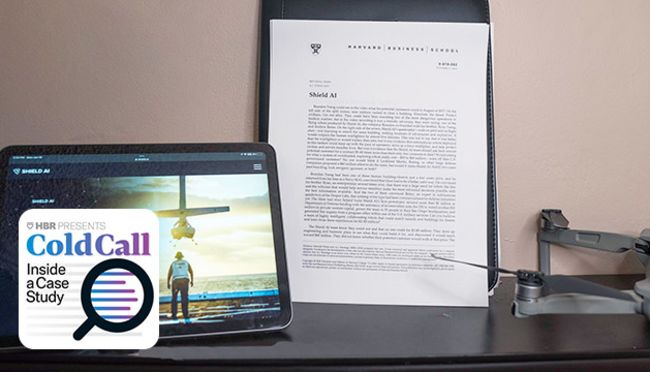
- 11 Jan 2022
- Cold Call Podcast
Can Entrepreneurs and Governments Team Up to Solve Big Problems?
In 2017, Shield AI’s quadcopter, with no pilot and no flight plan, could clear a building and outpace human warfighters by almost five minutes. It was evidence that autonomous robots could help protect civilian and service member lives. But was it also evidence that Shield AI—a startup barely two years past founding—could ask their newest potential customer, the US government, for a large contract for a system of coordinated, exploring robots? Or would it scare them away? Harvard Business School professor Mitch Weiss and Brandon Tseng, Shield AI’s CGO and co-founder, discuss these and other challenges entrepreneurs face when working with the public sector, and how investing in new ideas can enable entrepreneurs and governments to join forces and solve big problems in the case, “Shield AI.” Open for comment; 0 Comments.

- 06 May 2021
How Four Women Made Miami More Equitable for Startups
A case study by Rosabeth Moss Kanter examines what it takes to break gender barriers and build thriving businesses in an emerging startup hub. Open for comment; 0 Comments.

- 20 Apr 2021
- Working Paper Summaries
The Emergence of Mafia-like Business Systems in China
This study sheds light on the political pathology of fraudulent, illegal, and corrupt business practices. Features of the Chinese system—including regulatory gaps, a lack of formal means of property protection, and pervasive uncertainty—seem to facilitate the rise of mafia systems.
- 02 Feb 2021
Nonprofits in Good Times and Bad Times
Tax returns from millions of US nonprofits reveal that charities do not expand during bad times, when need is the greatest. Although they are able to smooth the swings of their activities more than for-profit organizations, nonprofits exhibit substantial sensitivity to economic cycles.

- 01 Feb 2021
Has the New Economy Finally Arrived?
Economists have long tied low unemployment to inflation. James Heskett considers whether the US economic policy of the past four years has shaken those assumptions. Open for comment; 0 Comments.
- 06 Jan 2021
Aggregate Advertising Expenditure in the US Economy: What's Up? Is It Real?
We analyze total United States advertising spending from 1960 to 2018. In nominal terms, the elasticity of annual advertising outlays with respect to gross domestic product appears to have increased substantially beginning in the late 1990s, roughly coinciding with the dramatic growth of internet-based advertising.

Connect with Us
- Entertainment
- Gadgets Review
- Government Schemes
- Make Money Online
- Product Review
- Uncategorized
Solving Case Study in Economics: A Complete Guide
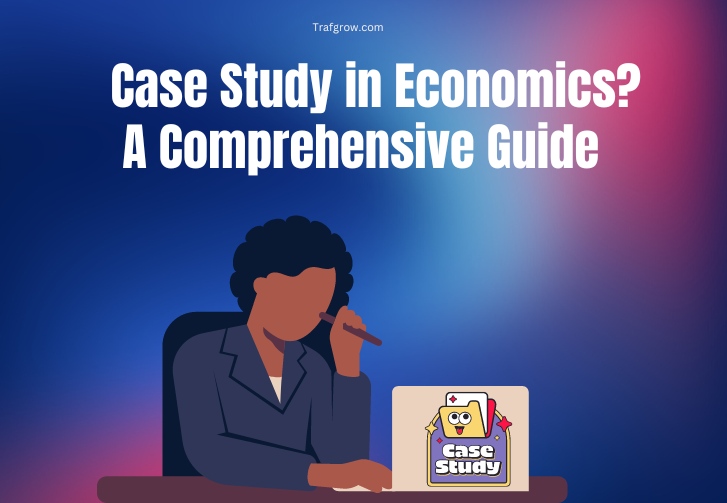
case study in economics
Case studies are invaluable in economics education, providing students with real-world scenarios to apply theoretical concepts and analytical skills. However, solving a case study in economics requires a structured approach that combines research, critical thinking, and a deep understanding of economic principles. This post presents a comprehensive guide on effectively solving a case study in economics , ensuring a thorough analysis and a grasp of practical implications.
Understanding the Case Study
Read carefully: .
Begin by reading the case study thoroughly. Pay attention to the details, context, and objectives presented. Identify the main issues, stakeholders, and the economic concepts at play.
Define the Problem:
Clearly define the economic problem or challenge presented in the case study. What are the fundamental problems that ought to be handled? Understanding the problem is crucial before proceeding with analysis.Identify the central economic problem or challenge that the case study presents. This could involve issues related to demand and supply, market structures, externalities, government interventions, or any other economic concept.
Gathering Relevant Information
Research: .
Conduct thorough research to gather additional information relevant to the case study. This may involve exploring economic theories, statistical data, and industry trends. Reliable sources such as academic journals, government reports, and reputable news outlets are valuable.
Identify Variables:
Identify the variables affecting the situation presented in the case study. These could include economic indicators, market conditions, government policies, etc.
Read also: How Trademark Registration Can Help in Business
Applying Economic Concepts
Use relevant theories: .
Apply relevant economic theories and concepts to analyze the case study. Consider concepts like supply and demand, elasticity, market structure, cost analysis, and utility theory, depending on the case context.
Quantitative Analysis:
If applicable, use quantitative methods such as calculations, graphs, and charts to illustrate your analysis. These tools can help visualize economic relationships and trends.
Data Interpretation
Cause and effect:.
Identify the cause-and-effect relationships driving the economic situation in the case study. Analyze how changes in one variable can impact others and lead to specific outcomes.
Consider Alternatives:
Explore solutions or strategies to address the issues presented. Consider the possible benefits and drawbacks of each option.
Making Recommendations
Informed decisions: .
Based on your analysis, make informed recommendations for addressing the challenges outlined in the case study in economics. Your recommendations should be rooted in economic theories and supported by your gathered data.
Justify Your Recommendations:
Clearly explain the rationale behind your recommendations. How will they positively impact the stakeholders involved? Justify your choices with economic logic.
Read also: Best Practices for Workday Financial Management Integration
Tips for Success
Practice: .
The more case studies you solve, the more comfortable you’ll become with the process. Practice hones your analytical skills and enables you to apply economic concepts effectively.
Collaborate:
Engage in discussions with peers or instructors. Collaborative analysis can offer diverse perspectives and deepen your understanding of the case.
Real-World Context:
Relate the case study to real-world economic scenarios. Understanding the practical implications of your analysis adds depth to your recommendations.
Stay Updated:
Case study in economics is a dynamic field. Stay updated with current economic trends, policy changes, and market developments to enhance the relevance of your analysis.
Read the Case Thoroughly
Begin by reading the case study attentively. Familiarize yourself with the context, characters, and economic issues presented. Take notes as you read to highlight key information and identify the main problems.
Apply Relevant Economic Concepts
Next, apply the economic concepts and theories you’ve learned in your coursework to the identified problem. Consider how concepts like elasticity, opportunity cost, marginal analysis, and cost-benefit analysis can be applied to the situation.
Collect Data and Information
Gather relevant data and information that can support your analysis. This may include statistical data, market trends, historical information, and other relevant sources that substantiate your arguments.
Analyze and Evaluate
Conduct a thorough analysis of the situation. Identify the factors contributing to the problem and evaluate their impact. Use graphs, charts, and diagrams to represent your analysis and provide clarity visually.
Explore Alternatives
Generate possible solutions or alternatives to address the identified problem. Consider the pros and cons of each solution, keeping in mind economic feasibility, ethical implications, and potential outcomes.
Apply Economic Theories
When formulating solutions, apply economic theories and principles that align with the situation. For instance, if you’re dealing with a market failure, explore how government intervention or corrective measures can be applied based on economic theories like externalities or public goods.
Quantitative Analysis
If applicable, perform quantitative analysis using relevant mathematical or statistical tools. This could involve calculating elasticity break-even points or analyzing cost structures to support your recommendations.
Justify Your Recommendations
Ensure that your solutions are well-justified and backed by solid economic reasoning. Explain how each solution addresses the problem and aligns with economic theories.
Consider Real-World Constraints
Acknowledge any real-world constraints that might affect the implementation of your recommendations. This could include budgetary limitations, political considerations, or social factors.
Solving an case study in economics writing is an enriching experience that bridges theory and practice. It requires a structured approach, from understanding the case to making well-informed recommendations. By thoroughly analyzing the economic concepts, interpreting data, and applying relevant theories, you can arrive at strategic solutions that align with economic principles.
Leave a Reply Cancel reply
Your email address will not be published. Required fields are marked *
Save my name, email, and website in this browser for the next time I comment.
Related News

How to migrate from Wix to WordPress – Ultimate Guide

7 Best Team Collaboration Tools for Remote & In-Person
You may have missed.

How to Personalize Custom Boxes for Special Occasions?


How to Fix NVIDIA GeForce Experience Error Code 0x0003

Style Mastery: Essential Tips for Every Woman’s Occasion

Creating High-Performance Teams for Success

Health and Insurance Bridging the Gap of Technology

UBO Verification: Understand the Ultimate Beneficial Owners

Library subject guides
- Key resources
- Books and e-books
- Statistics and country information
Case studies
Recommended databases: case studies, other databases: case studies, streaming videos: case studies.
- Company and industry information, financials
- Additional information
Case studies describe real world practical examples, including successes, issues and challenges. To find case studies using LibrarySearch or databases, add "case study" to your search terms.
- The case study handbook a student's guide This e-book provides tips on how to read, analyse and write about cases.
- Business source complete (EBSCO) Contains case studies from many sources. They can be found using advanced search and selecting "case study" as the Document Type.
- Harvard Business Review Journal of Harvard Business School that covers a wide range of business topics. Click “Search within this publication” and input search terms, then limit results by “Subject” to “Case studies”.
- Harvard Business Review Digital Articles Digital articles uploaded from the HBR.org site. Click “Search within this publication” and add “Case study” as a search term.
- Henry Stewart talks: The business and management collection A collection of video lectures, case studies and seminar-style talks. Subject areas include marketing & sale, global business management, organisation, commerce, technology, and operations.
- Emerald Insight An extensive business research database. Click on advanced search and then select the case studies checkbox.
- MarketLine Case Studies (Datamonitor) Explore business practices across a variety of industry sectors. Select "Analysis" from the menu bar and select Case studies. A selection of pre 2008/9 reports are also available from LibrarySearch; search for "Datamonitor Case Studies”.
- Factiva Use "case study" or "case studies" as terms when building your search. There is no option to limit to case studies as a resource type.
- SAGE Business cases Access to authoritative cases from over 100 countries. SAGE curates interdisciplinary cases on in-demand subjects such as marketing, entrepreneurship, accounting, healthcare management, leadership, social enterprise, and more.
- Arthur Andersen Case Studies in Business Ethics 90 case studies that highlight awareness of ethical issues in business.
- Business Case Studies Uses real information and issues from featured companies.
- Markkula Center for Applied Ethics - ethics case studies Find case studies and scenarios on a variety of fields in applied ethics.
- MIT LearningEdge Case Studies Some of the case studies featured on LearningEdge highlight the decision-making process in a business or management setting.
Case studies in video documentary format are available from these video streaming databases.
- ClickView A collection of educational videos, including professional development videos and case studies. To access you will need to use your RMIT student login. Streaming videos covering a variety of disciplines. Enter your search terms and then narrow using the “case study” Tag.
- Alexander Street A collection of documentaries, features, educational and informative videos (and audio), and archival material. Also includes industry specific textbooks, book chapters, corporate training videos, case studies and executive-oriented research reports. Enter your search terms and then filter your result by selecting “Case Study” as your Content Type.
- Kanopy Business Case Studies A selection of streaming videos examining companies, marketing strategies, and entrepreneurs. Browse the “Business” section and select “Business Case Studies”.
Finding case studies
The Library's Finding Case Studies guide explains different types of case studies and how to find them.

Writing a case study

See the Learning Lab tutorial on Writing a Case Study to find out how to read, analyse and respond to a case study.
- << Previous: Videos
- Next: Company and industry information, financials >>
- Last Updated: Feb 12, 2024 7:07 PM
- URL: https://rmit.libguides.com/economics
Home > Case Studies
Case Studies
Discover all the ways our 2,000 customers succeed, thrive and grow with Oxford Economics. Read success stories from Oxford Economics' clients in sectors such as pensions, energy and Real Estate. Learn how they solved their business challenges, supported their businesses' growth and adapted to new markets using Oxford Economics market-leading consulting and subscription services.

Case Study | Multinational Drinks Company
Bespoke dashboards and agile on-demand economics support
Background Today’s turbulent macroeconomic and consumer environment makes strategy and planning particularly difficult for firms in the business-to-consumer sector. The pandemic, major global conflicts and geopolitical tensions have caused major supply-side disruptions. At the same time, the ever-changing consumer environment, recent unprecedented levels of inflation and the ensuing cost of living crisis have been a...

Case Study | Royal London
Exploring the implications of higher pension contributions
Many households fail to save adequately for retirement. Using in-house models, the study assesses the impact of higher pension contributions on both pension savings and UK economic growth.

Case Study | A global aggregate and building materials provider
Constructing Success by Capitalising on Long-Term Opportunities
Helping a strategy department identify its 10-year growth opportunities

Case Study | Semiconductor Industry Association
A unique policy-driven impact scenario for CHIPS Act
How Oxford Economics engaged the world’s largest chip manufacturers to develop an industry-wide impact assessment of the CHIPS and Sciences Act.

Case Study | Building material manufacturer
Benchmarking Success: Building a Global Market Demand Indicator
Creating a new demand measure to enable a building material manufacturer to gauge its performance.

Case Study | Multinational services company
Quantifying the impact of climate on customers
Leveraging industry-specific climate forecasts to future-proof revenue.

Case Study | Energy UK
Achieving net zero advocacy goals
Highlighting the economic opportunities the energy transition presents and the consequences of not grasping them.

Charting a course for global growth in the shipping industry
Empowering a leading shipping company to enhance its strategic planning and identify new routes for growth

Global macroeconomic and risk scenario tool
Enabling a major automotive manufacturer to anticipate and respond effectively to evolving market dynamics across its global operations.

Risk signal identification, prioritisation and monitoring evaluation model
Despite existing internal risk management processes, a major automotive manufacturer was unprepared for and failed to anticipate and mitigate significant risks and shocks that have significantly affected its operations in recent years, including its sales, supply chain and financing.

Bespoke automotive sector sales forecasting
Automotive companies face many challenges: regulations, emission controls, litigation, political uncertainty, complex and problematic supply chains and disruptive technology are perhaps among the most pressing.

Case Study | Australian Finance Industry Association
The economic impact of Buy Now Pay Later in Australia
Governments globally are realising the importance of payments and financial services efficiency to economic growth, financial wellbeing and social participation. The Australian Finance Industry Association (AFIA) recognises innovation, competition, market efficiency, economic growth and consumer protection are interrelated and, therefore, must be addressed collectively. An informed understanding of the Buy Now Pay Later (BNPL) sector...

Case Study | City of Sydney
City of Sydney’s 2022 Business Needs Survey Report
The City of Sydney required an advisor with the capability to develop a high-impact, user-focused report to: The report had to be engaging and highly visual, containing a range of different devices to communicate economic insights to a range of readers. The solution Oxford Economics Australia developed a rich and compelling report to engage and...

Case Study | Leading Australian Law Firm
Expert Witness Report on property market influences and outlook
The repudiation of an existing development agreement resulted in Supreme Court proceedings whereby residential property market forecasts were required to demonstrate the outlook for the Darwin residential market at that time. Separate sale price and rent projections were needed (on an annual basis) for detached house and attached dwellings for the period of 2017-2030. Importantly,...

Case Study | QBE LMI
The Annual Housing Outlook 2022 – the Green Edition
The objective of this work was to reinforce QBE LMI’s position by providing an outlook of housing market performance and stimulate informed discussion about environmental sustainability within the housing market and a state by state performance analysis of housing market prices and rents. The solution The project was approached collaboratively with the QBE LMI project...

Case Study | Australia Energy Market
Forecasts and scenarios to inform the future of Australia’s energy market
Oxford Economics Australia was commissioned to produce macroeconomic and commodity scenario projections that could be used to generate long-term gas and electricity demand and supply projections across a range of energy transition scenarios. The solution We worked closely with the client’s team and their stakeholders to produce long-term (30-year) macroeconomic and commodity price forecasts, across...

Case Study | National Bureau of Statistics
Developing a leading statistical ecosystem to empower decision makers in government, the private sector and broader society
The National Bureau of Statistics asked Oxford Economics to redesign its existing statistical publications to make them more user-focused. This included: The solution Oxford Economics worked closely with the National Bureau of Statistics over a period of six months to develop 57 redesigned publication templates. The work was completed in two broad stages: The final...
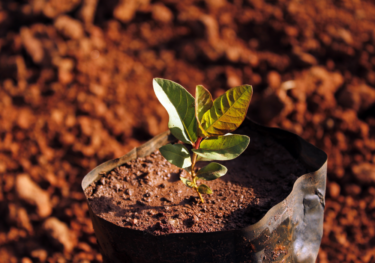
Case Study | Schroders
Understanding climate-related implications on investment strategies
As global awareness of climate change continues to increase, investors are beginning to consider how climate risks and opportunities may affect long-term investment strategies and returns. Our client, Schroders, a large asset manager, is no exception, which is why they switched to our Global Climate Service as the economic foundation for their long-run asset class publication.

Case Study | Life insurance company
Improved research processes and forecasting accuracy
A leading life insurance company has used Oxford Economics' Global Economic Model to improve their global economic research processes and increase the accuracy of their own economic forecasts.

Case Study | Large global pension fund
Supporting investment strategy with long-term perspectives
Overview To make long-term investments, investors need long-term thinking. That’s why one of the largest pension funds globally subscribed to Oxford Economics’ Global Macro Service, Global Cities Service and Regional City Services. They currently use our macroeconomic forecasts as one of the references in reviewing market fundamentals for investment. The Challenge As long-term investors, our...
Find out how Oxford Economics can help you on your path to business growth

Sign up to our Resource Hub to download the latest and most popular reports.
Select to close video modal
Select to close video modal Play Video Select to play video

Economic Impact Case Study Tool for Transit (2016)
Chapter: chapter 1 - background and objectives.
Below is the uncorrected machine-read text of this chapter, intended to provide our own search engines and external engines with highly rich, chapter-representative searchable text of each book. Because it is UNCORRECTED material, please consider the following text as a useful but insufficient proxy for the authoritative book pages.
3 C H A P T E R 1 1.1 Report Objectives and Outline Objective There are several possible reasons to follow up after trans- portation projects are completed to see their actual results and impacts (i.e., âex postâ analysis). These reasons span five broad classes: 1. To inform public policy discussion by developing enhanced rules of thumb (better expectations) regarding the range of impacts likely to result from various types of projects; 2. To provide insight for planners (lessons learned) regard- ing factors and processes that affect project outcomes and that need to be considered in project development and implementation; 3. To validate analysis methods by determining the accuracy of current analysis methods used to predict costs and/or benefits and to enable improvement in future prediction methods; 4. To confirm investment justifications by determining the extent to which a program or policy is achieving intended effects and, hence, is worthy of continued funding and operation; and 5. To assemble data for subsequent statistical analysis and mar- ket research on the relationships of transportation invest- ment, land development, and economic development. While there is existing data on changes over time in vehic- ular traffic and transit ridership that can be linked to indi- vidual transportation projects, there is far less information available that documents the economic impacts from land development responses to individual transportation projects. So while all of the above justifications can apply for following up on transportation and travel impacts of completed proj- ects, they are equally (or perhaps more) needed to under- stand the broader economic and land development impacts of projects. The lack of consistent information on the economic development impacts of transportation is not limited to transit. There is a general shortage of valid before-and-after economic impact studies regarding transport investments. When such studies are done, impact data are rarely collected consistentlyâeven when done for a specific mode and even when applied to impacts that are less complex than economic development. Thus, there is a clear need for more post-project impact studies, organized in a consistent manner and accessible via a searchable database. This study represents an initial step toward development of case studies to portray the actual, observed economic impacts of transit projects. It examines issues arising in the develop- ment of transit impact case studies, and it illustrates how case studies can be conducted. The emphasis here is on providing planning and policy insights (the first two of the above-listed five reasons for conducting ex post analysis). Such a tool can be used to support project screening and sketch level plan- ning, to support early stage public discussions (by tempering unrealistically optimistic or pessimistic expectations), and to help define supporting strategies to bolster desired economic development outcomes. Overview This report summarizes the findings of TCRP Project H-50, a research effort to develop a prototype for a national database of case studies pertaining to the economic and land develop- ment impacts of transit projects. This effort included (a) identi- fication of potentially applicable case studies; (b) development of protocols for data collection and impact measurement; (c) a searchable database design for maintaining records and reporting on findings; and (d) pilot implementationâwhich consisted of completing seven case studies and making them accessible via a web-based user interface. The overall system design for transit project case studies that was refined and implemented for this study was specifically designed to follow Background and Objectives
4the general standard of a previously developed format for highway project case studies, although it has been specifically adapted here to be applicable for transit projects. This report is organized into five chapters with three appen- dices. Chapter 1 covers the project background and objectives. Chapter 2 describes the process that was used in this study to identify and select applicable case studies. Chapter 3 describes the web-based database containing case study information and the system for reporting economic impact results. Chapter 4 provides guidance on how to develop additional case studies and how to use the information for planning and policy analy- sis. Chapter 5 discusses issues and follow-on research regard- ing the development of a more complete system of transit impact case studies. There are also three appendices: a âdata- base dictionaryâ of information content, information about further training materials on the web, and detailed informa- tion assembled for the individual case studies. 1.2 Building on a Prior History of Case Study Analysis In the United States, documentation of economic impacts from built transportation investments goes back to the Erie Canal, which opened in 1820 to connect agricultural regions in the Ohio Valley to East Coast population centers. Follow-up observations showed a twenty-fold drop in the price of wheat in urban markets, followed by a massive movement of popu- lation and economic activity to the Ohio Valley (New York State Archives, 2014). Case Studies for Highway Projects Starting in the 1990s, there was a flurry of systematic activ- ity to document the economic impacts of individual road projects. This included pre/post studies of bypass projects in Wisconsin, Kansas, Iowa, Washington State, Texas, North Carolina, and others (these studies are reviewed in California Bypass Study [System Metrics Group, 2016]). The Appalachian Regional Commission also funded development of nearly 200 case studies on the actual observed impacts of road and other infrastructure projects as part of an effort to show outcomes of its Public Works program (Brandow, 2000; Brandow/ Bizminer, 2007). FHWA also funded a further series of case studies of major highway investments (FHWA, 2004) and issued a guide to use of empirical information to document the economic impact of past highway investments (EDR Group and Cambridge Systematics, 2001). Some local and state agencies have also funded case studies of past project experiences to help them with public involve- ment and planning processes for planned new projects. For instance, when it was considering a new highway interchange, the Pennsylvania Turnpike Commission funded a set of case studies of the economic impacts of other new highway inter- changes around the United States (Wray et al., 2000). Simi- larly, when Roanoke, Virginia, was considering the alignment of a new highway that could run through or around the city, it funded case studies of economic impacts in new highways along the outskirts and through the center of other cities (EDR Group, 2000). Case Studies for Transit Projects More recently, a series of research reports has been com- pleted that provide pre/post case study data regarding the impact of individual transit projects including line, corridor, and station area investments. In general, these reports have focused on demonstrating that transit projects can and do affect surrounding land use, land development, and job growth, although impacts differ across case studies depending on the nature of the specific project and its settings. These include case studies of station area development (Vincent and Jerram, 2008); rail transit corridors (Hook et al., 2013); fixed guideway transit (Chatman et al., 2014); and BRT impacts (Nelson and Ganning, 2015). There have also been statistical studies of the relationship between transportation investment and economic growth, but that line of researchâwhile important for showing the value of transportation fundingâdoes not provide the local details that arise from case studies of individual projects. TPICS and EconWorks While all of the preceding case study efforts contribute to the body of knowledge concerning economic and land devel- opment impacts of transportation, they have varied in the depth and breadth of their coverage, spanning different types of projects, different periods of impact measurement, differ- ent impact measures, and different forms of reporting. There has been a clear need to develop a more consistent national database of case studies that can cover broader types of proj- ects, broader settings, and broader forms of resulting impacts. In response to that and other research needs, in 2005, the U.S. Congress authorized the Second Strategic High- way Research Program (SHRP 2) to fund a variety of applied research efforts. Those efforts included the development of a national database of case studies to show the extent to which economic impacts occur as a result of highway investments. The research objectives of SHRP 2 Project C03 were stated as follows (SHRP 2, 2007): 1. To provide a resource to help determine the net changes in the economic systems of an area impacted by a transpor- tation capacity investment; the resource should include,
5 in an economic context, impacts on land use, land value, and the environment; 2. To provide data and results from enough structured cases that project planners in the future can use the cases to demonstrate by analogy the likely impacts of a proposed project or group of projects (plan); and 3. To demonstrate how this fits into collaborative decision- making for capacity expansion. The result of SHRP 2 Project C03 was a collection of 100 case studies of highway-related projects, offered via a search- able web-based database and accompanied by a research report that summarized statistical analysis of the case study outcomes (EDR Group et al., 2012). The case study system, called âTransportation Project Impact Case Studiesâ (TPICS), was managed by TRB. It can be viewed at www.tpics.us (Inter- net Explorer is the preferred browser). In 2014, TCRP approved funding of a pilot effort to extend the TPICS case study concept from highway-oriented projects (as required by SHRP 2) to also cover transit projects. This report describes the findings from that pilot effort (TCRP Project H-50). This product is referred to as âTPICS for Tran- sitâ to distinguish it from the original SHRP 2 product. It can be viewed at https://transit.tpics.us (Internet Explorer is the preferred browser). Meanwhile, the SHRP 2 program ended in 2015, and the original TPICS for highways was transitioned from TRB to sponsorship by FHWA and AASHTO, which updated the look of the TPICS visual interface and rebranded it as âEcon- Works Case Studies.â The change does not in any way affect the applicability of this studyâs results concerning the oppor- tunity to extend the highway case study database to also cover transit projects. The new interface can be viewed at https:// planningtools.transportation.org/13/econworks.html. The TPICS/EconWorks database of highway-oriented case studies, as well as the new transit case studies developed for this TCRP project, share a common set of intended uses, which focus on improving transportation planning and associated public discussion of transportation plans. This corresponds to Categories 1 and 2 of the five reasons for case studies that were cited on the first page of this section. The intention is to improve project planning and discussion in three ways: 1. To enable planners to establish the range of likely impacts associated with various types of projects in different set- tings. This can be particularly useful for early stage con- cept planning. 2. To enable transportation agency staff to cite real world examples at public meetings, helping to limit unreason- ably optimistic hopes or overly pessimistic fears about proposed projects. 3. To enable better project designs, plans, and implemen- tation processes by pointing out factors that have been found to accentuate or mitigate positive and negative impacts. The TPICS/EconWorks database system was also designed to enable export of all data so that it can be eventually used for further research once there are enough case observations to support such analysis. This corresponds to Categories 3, 4, and 5 of the five motivations for case studies. 1.3 TCRP Study Report This report presents results of the TCRP Project H-50. It describes the pilot design and framework for a national database of case studies that measure the observed, actual land development impacts and associated economic impacts of public transit investments (not construction or transit operations and maintenance impacts). It was based on the assumption that transit cases can be developed in a man- ner consistent with the pioneering database that was suc- cessfully established for highway projects under SHRP 2 as TPICS (and which is now being continued as Econ- Works). In this proposal, we refer to the transit extension as âTPICS-Transit.â This project was established to provide three meaningful outcomes: 1. To extend the breadth and use of the TPICS web tool frame- work to cover transit. It addressed this goal by developing a database and user interface that copies the existing TPICS framework but modifies it as required to apply to public transportation investments. This final report notes the type of changes made and ways that the TPICS structure can be more broadly applied. 2. To advance the measurement of permanent economic impacts associated with public transit. It addressed this goal by pro- viding a common framework for measuring impacts associ- ated with completed transit projectsâbuilding an initial set of pilot case studies that use this frameworkâby develop- ing a database that can include many more transit cases in the future and by identifying the type of effort needed to continue that effort beyond this project. 3. To advance the broader process of ex post analysis. It addressed this goal by extracting lessons learned regarding how data assembly and measurement methods may differ between expansion of services (such as public transportation) and facilities (such as highways). The report also notes chal- lenges and opportunities for using case study databases of this type for future planning and research applications.
6Readers of this report (and particularly its final chapter) will note that it also includes discussion of the many current data limitations affecting existing transit case studies as well as potentials for broader use that may become possible in the future. That is an important pointâthat the develop- ment of ex post case studies and a national database of case study information is still in its infancy, and there is a need for ongoing support to keep this case study data- base alive and eventually expand its capabilities and uses. Thus, in the long run, this report and its case study exam- ples should be seen as a way to inform discussion and to demonstrate what economic analysis case studies can and cannot do. It should be clear to readers that the current database of case studies is not a statistically controlled data set, but rather a collection of examples selected to support both planning and project review processes by illuminating the way that project features, their spatial settings, and their broader implementa- tion contexts all interact to affect economic and land develop- ment outcomes.
TRB's Transit Cooperative Research Program (TCRP) Report 186: Economic Impact Case Study Tool for Transit presents the results of a project aimed at creating the prototype for a searchable, web-based database of public transit investment projects and their associated, transit-driven economic and land development outcomes. This information is intended to inform future planning efforts for transit-related projects, and to support better multi-modal planning.
This TCRP project builds upon a database established for highway projects under TRB’s second Strategic Highway Research Program (SHRP2) called Transportation Project Impact Case Studies (TPICS). The purpose of TPICS is to provide transportation planners with a consistent base of data on actual, documented economic and land development impacts of completed transit-related investments, along with descriptions of the nature and associated factors of the impact.
The report covers the design and development of the case study database and web tool, and includes a set of seven prototype case studies. The web tool and prototype cases can be found at http://transit.tpics.us .
READ FREE ONLINE
Welcome to OpenBook!
You're looking at OpenBook, NAP.edu's online reading room since 1999. Based on feedback from you, our users, we've made some improvements that make it easier than ever to read thousands of publications on our website.
Do you want to take a quick tour of the OpenBook's features?
Show this book's table of contents , where you can jump to any chapter by name.
...or use these buttons to go back to the previous chapter or skip to the next one.
Jump up to the previous page or down to the next one. Also, you can type in a page number and press Enter to go directly to that page in the book.
To search the entire text of this book, type in your search term here and press Enter .
Share a link to this book page on your preferred social network or via email.
View our suggested citation for this chapter.
Ready to take your reading offline? Click here to buy this book in print or download it as a free PDF, if available.
Get Email Updates
Do you enjoy reading reports from the Academies online for free ? Sign up for email notifications and we'll let you know about new publications in your areas of interest when they're released.

Improving economics teaching and learning for over 20 years
Microeconomic Case Studies
An economics network funded project 2006-7.
Project leader: Ms. A. Vindelyn Smith-Hillman Contact: [email protected]
- Teaching guide
- Answer guide
- Student handout
The case studies aim to provide an applied contemporary vehicle to engage economic students in an area of familiarity. All too often microeconomics is perceived as being essentially a theoretical tool in which models and accompanying diagrams are memorised with little understanding of their significance in policy application.
It is anticipated that the case study approach will foster analytical development and also cater to mainstream business students who are taking an economics minor thereby widening participation in economic disciplines.
It is also intended that the case study vehicle provides a means of reaching out to developing country economic lecturers through suggesting alternative assessment. It affords the opportunity for oral assessment as against sole reliance on written assessment. In addition to written skills therefore, it offers the potential for development of social skills and enables students to learn by doing. Similar cases can be developed for the developing country context, in any case anti-competitive conduct pursued by a multinational corporation is often not isolated to a particular region, or if it is, developing countries bear the brunt.
See also case studies of mathematical concepts in Economics
- 78606 views
- Views on request
Disciplines in Nigeria
Case studies: successful agricultural economics projects in nigeria.
Last Updated on December 8, 2023
Introduction
Brief overview of agricultural economics in nigeria.
Agricultural Economics Projects in Nigeria: In Nigeria, agricultural economics stands as a cornerstone, intertwining livelihoods with the nation’s economic fabric.
A rich tapestry of diverse climates and fertile lands propels agriculture, making it a pivotal sector.
Importance of Successful Agricultural Projects
The success of agricultural projects isn’t just measured in yields; it’s a catalyst for socio-economic upliftment. Flourishing farms mean enhanced food security, increased employment, and a robust rural economy.
The interplay between successful agricultural ventures and broader economic prosperity is undeniable.
Purpose of the Blog Post
This blog post delves into real-life success stories, shining a spotlight on impactful agricultural ventures in Nigeria.
By dissecting the intricacies of these projects, we aim to draw insights, inspire future initiatives, and underline the critical role of agricultural economics in national development.
Each case study unfolds as a testament to the transformative power of strategic planning, innovation, and community engagement in the agricultural landscape.
As we embark on this journey, be prepared to explore the stories behind the thriving fields and the faces of individuals whose perseverance has turned soil into gold.
This isn’t just a documentation of triumphs; it’s a call to action, urging stakeholders to amplify their efforts in shaping a resilient and prosperous agricultural future for Nigeria.
Stay tuned for our first case study, where we unravel the nuances of a groundbreaking initiative that not only boosted crop yields but also elevated the livelihoods of countless farmers.
The saga begins, and the lessons are bound to resonate far beyond the fields.
Case Study 1: The FADAMA Project
The FADAMA Project in Nigeria has been a remarkable success in improving agricultural economics and enhancing the livelihoods of farmers.
Let’s delve into the background information of this project and explore its achievements, economic benefits, and lessons learned.
Background information on The FADAMA Project
The FADAMA Project is primarily based in Nigeria, a country renowned for its vast agricultural potential.
Its key objective is to boost agricultural productivity and improve the livelihoods of farmers across the nation.
The project specifically targets areas with favorable climatic conditions and fertile land, ensuring optimal agricultural outcomes.
The FADAMA Project receives funding from the World Bank, which recognizes the importance of investing in agricultural development for sustainable economic growth.
This financial support has enabled the project to implement innovative strategies and advanced technologies to uplift Nigeria’s agricultural sector.
Success story of The FADAMA Project
The achievements and impact of The FADAMA Project have been staggering.
By introducing modern farming techniques, providing training, and facilitating access to improved seeds and fertilizers, the project has significantly increased agricultural productivity in Nigeria.
Farmers have reported higher crop yields and improved quality, leading to increased incomes and greater food security.
The economic benefits of The FADAMA Project are multi-faceted. The enhanced agricultural productivity has not only improved the living standards of farmers but has also contributed to the national economy.
The increased production has created a surplus, allowing for exports and reducing dependency on food imports.
This boosts Nigeria’s overall trade balance and strengthens its agricultural sector, paving the way for sustained economic growth.
Moreover, The FADAMA Project has served as a valuable learning experience for agricultural development in Nigeria.
The project has identified crucial lessons that can guide future initiatives.
These lessons include the importance of technology transfer, farmer empowerment through training and capacity building, and the significance of sustainable and inclusive agricultural practices.
The FADAMA Project has set a benchmark for successful agricultural economics projects in Nigeria.
In fact, The FADAMA Project in Nigeria has been instrumental in transforming agricultural economics and improving the lives of farmers.
With its location in Nigeria, objective to enhance productivity, and funding from the World Bank, the project has achieved remarkable success.
The project’s achievements, economic benefits, and lessons learned provide a strong foundation for future agricultural development initiatives in Nigeria and beyond.
Read: The Role of Agricultural Extension in Nigeria’s Economy
Case Study 2: The Agricultural Growth and Investment Plan (AGRIP)
Background information on agriculture project b.
In the heart of Nigeria, Agriculture Project B thrived in the fertile landscapes of Kano State.
The primary aim was to enhance food security by promoting sustainable farming practices and increasing agricultural productivity.
Funding Source
Generously funded by a collaboration between the Nigerian government and a renowned international agricultural development organization.
Success Story of Agriculture Project B
Achievements and impact.
Agriculture Project B achieved remarkable milestones, witnessing a significant surge in crop yield and livestock production. The project substantially contributed to food self-sufficiency in the region.
Economic Benefits
The economic impact was profound, with a substantial increase in farmers’ income and employment opportunities.
The ripple effect reached beyond the agricultural sector, positively influencing the overall economic landscape.
Lessons Learned
The success of Agriculture Project B underscored the importance of community engagement, sustainable farming techniques, and strategic partnerships.
It taught us that investing in agricultural projects can be a catalyst for holistic economic development.
In the lush fields of Kano State, Agriculture Project B emerged as a beacon of success, transforming the agricultural landscape and uplifting the community.
Through meticulous planning and strategic collaboration, the project not only met its objectives but surpassed expectations, leaving an indelible mark on Nigeria’s agricultural economy.
The story of Agriculture Project B is a testament to the transformative power of well-executed agricultural initiatives, offering valuable lessons for future endeavors in sustainable development.
Read: Challenges and Solutions in Nigeria’s Agricultural Extension
Case Study 3: The World Bank’s Smallholder Agriculture Transformation and Agribusiness Revitalization Project (STAR-P)
Background information on star-p.
Case Study 3 focuses on the Smallholder Agriculture Transformation and Agribusiness Revitalization Project (STAR-P), an initiative spearheaded by The World Bank in Nigeria.
This project aims to transform smallholder agriculture and revitalize agribusiness, ultimately promoting economic growth and development in the country.
Located in Nigeria, STAR-P has been designed to achieve several objectives.
The primary goal is to enhance agricultural productivity among smallholder farmers, enabling them to contribute significantly to Nigeria’s food security and economic stability.
Additionally, the project seeks to promote sustainable agricultural practices, improve access to financial services and markets, and strengthen the overall agribusiness value chain.
To support the implementation of STAR-P, The World Bank has provided substantial funding.
This financial backing has been crucial in ensuring the project’s success and sustainability, enabling the deployment of essential resources and technical assistance.
Success story of STAR-P
The success of STAR-P is evident in the achievements and impact it has made in the agricultural sector in Nigeria.
The project has significantly increased crop yields and livestock production, leading to improved food production and reduced dependency on imports.
Moreover, through the adoption of modern farming techniques and access to better inputs and technologies, smallholder farmers have experienced a substantial increase in their income levels, ultimately uplifting their households and communities.
The economic benefits generated by STAR-P extend beyond the smallholder farmers themselves.
The project has stimulated rural development by creating employment opportunities and generating income for various actors within the agribusiness value chain, including processors, distributors, and retailers.
This ripple effect has contributed to poverty alleviation and a more inclusive economy.
Throughout its implementation, the STAR-P project has revealed essential lessons for future agricultural economics projects.
One crucial lesson learned is the effectiveness of targeted interventions.
By focusing on smallholder farmers and the agribusiness value chain, the project has maximized its impact and generated sustainable outcomes.
Additionally, collaboration among stakeholders has been a critical component of STAR-P’s success.
The World Bank, government agencies, non-governmental organizations, and local communities have worked together to ensure the project’s smooth implementation and continued growth.
This collaborative approach has fostered knowledge sharing, innovation, and the ability to address diverse challenges effectively.
In short, the Smallholder Agriculture Transformation and Agribusiness Revitalization Project (STAR-P) in Nigeria, supported by The World Bank, stands as a successful case study in agricultural economics.
Through targeted interventions and collaboration, the project has achieved remarkable outcomes, including improved productivity, economic benefits, and valuable lessons for future projects.
STAR-P serves as an exemplar for other countries and organizations seeking to transform agricultural systems and promote rural development.
Read: The Intersection of Agri-Coop Management and Agri-Business in Nigeria

Comparison of the Case Studies
Commonalities among the successful projects.
- Both projects focused on improving agricultural practices.
- They aimed to increase crop yield and farmers’ income.
- Both projects were implemented in rural areas of Nigeria.
- They utilized modern farming techniques and technologies.
- Both projects received support from governmental and non-governmental organizations.
Differences in terms of location, objective, and funding
- Project A was located in the northern region, while Project B was in the southern region of Nigeria.
- Project A aimed to promote wheat cultivation, while Project B focused on cassava production.
- Project A was funded mainly by international donors, while Project B received funding from the Nigerian government.
- The objectives of Project A included reducing wheat importation and improving food security, whereas Project B aimed to increase cassava exportation.
Critical factors contributing to their success
- Active involvement and participation of local farmers and communities.
- Effective training and capacity building programs for farmers.
- Access to high-quality seeds, fertilizers, and modern farming equipment.
- Availability of reliable irrigation systems and water resources.
- Collaboration between agricultural experts, researchers, and extension officers.
- Government policies and support that created an enabling environment for agricultural development.
- Successful market linkages and access to agricultural value chains.
- Sustainable and efficient management of resources and agricultural inputs.
- Continuous monitoring, evaluation, and knowledge-sharing among project stakeholders.
- Adoption of climate-smart agricultural practices and resilience to climate change.
- Engagement with and participation of women and youth in agricultural activities.
Basically, the successful agricultural economics projects in Nigeria share commonalities in their focus on improving agricultural practices, increasing crop yield, and benefiting farmers in rural areas.
However, they differ in terms of location, objectives, and funding sources.
The critical factors contributing to their success include active involvement of farmers, access to necessary resources and technologies, government support, effective market linkages, and adoption of sustainable practices.
By analyzing these case studies, valuable lessons can be learned to replicate and scale successful agricultural projects in Nigeria and beyond.
Read: Examining the Curriculum: Agri-Cooperative Courses in Nigeria
Lessons Learned and Recommendations
Key lessons learned from the case studies.
- Local community participation is crucial for the success of agricultural economics projects in Nigeria.
- Effective resource management plays a significant role in achieving sustainable outcomes.
- Adaptability and flexibility are essential to overcome challenges faced in agricultural projects.
- Investment in research and development is vital to improve agricultural practices and productivity.
- Effective communication and coordination between stakeholders lead to better project outcomes.
- Training and capacity building programs empower farmers and enhance their skills and knowledge.
- Integration of modern technology and innovation can revolutionize the agricultural sector in Nigeria.
- Promoting gender equality and inclusivity within projects contributes to their success.
- Maintaining a sustainable and eco-friendly approach is crucial for the long-term impact of projects.
Recommendations for implementing successful agricultural economics projects in Nigeria
- Engage local communities from project inception to ensure their active participation and ownership.
- Establish effective monitoring and evaluation systems to track project progress and identify areas for improvement.
- Encourage public-private partnerships to enhance resource mobilization and leverage expertise.
- Promote market-oriented approaches and value chain development to improve farmers’ income.
- Invest in infrastructure development for efficient agricultural production, storage, and transportation.
- Facilitate access to credit and financial services for small-scale farmers to stimulate growth.
- Prioritize research and development to introduce innovative technologies and practices.
- Strengthen extension services to provide continuous support and knowledge transfer to farmers.
- Implement gender-responsive strategies to empower women farmers and promote equal opportunities.
- Ensure sustainable land and water management practices to mitigate environmental degradation.
Importance of knowledge sharing and collaboration within the agricultural sector
The case studies highlight the significance of knowledge sharing and collaboration within the agricultural sector in Nigeria.
Successful projects have showcased the positive outcomes achieved when stakeholders, including farmers, policymakers, researchers, and development organizations, work together towards a common goal.
Sharing knowledge and experiences helps avoid duplication of efforts, enhances learning, and accelerates progress in the agricultural sector.
It promotes the exchange of best practices, innovative ideas, and lessons learned from both successful and failed projects.
Collaboration also enables stakeholders to pool resources, expertise, and technical know-how, creating a more holistic approach to addressing challenges and maximizing the impact of agricultural economics projects.
Furthermore, knowledge sharing and collaboration foster synergy among different actors, leading to greater coordination, policy coherence, and effective implementation of agricultural initiatives.
It encourages the adoption of evidence-based decision-making, where stakeholders can draw on shared experiences to develop context-specific solutions and strategies.
To facilitate knowledge sharing and collaboration, platforms such as conferences, workshops, and online forums should be established to create opportunities for stakeholders to connect, learn from each other, and form partnerships.
Additionally, government agencies and development organizations should invest in strengthening agricultural networks and knowledge-sharing platforms, both at the national and regional levels.
Essentially, the lessons learned from successful agricultural economics projects in Nigeria, along with the recommended strategies, emphasize the importance of collaboration, knowledge sharing, and adopting a participatory approach.
By implementing these recommendations, Nigeria can harness its agricultural potential, improve food security, enhance rural livelihoods, and achieve sustainable economic growth.
To recap, successful agricultural projects play a crucial role in Nigeria.
They not only contribute to economic development but also improve the lives of many Nigerian farmers and their communities.
With the vast potential of Nigeria’s agricultural sector, there is a great opportunity for further growth and prosperity.
It is imperative for stakeholders to recognize this potential and invest resources and support into agricultural economics projects.
As we conclude, let us recognize the importance of continued investment in Nigeria’s agricultural sector.
This call to action is not only for the government but also for private entities, both national and international, to collaborate and provide the necessary resources and expertise.
By investing in agricultural projects, we can foster economic growth, alleviate poverty, and create sustainable livelihoods for Nigerian farmers.
Together, we can unlock the full potential of Nigeria’s agricultural sector for the benefit of all.
- The Role of Agricultural Extension in Nigeria’s Economy
- Role of Agricultural Economists in Nigeria’s Rural Development
You May Also Like

Evolution of Animal Production Education in Nigeria

A Deep Dive: Rural Development & Agri-Cooperatives in Nigeria

Postgraduate Opportunities in Architectural Technology in Nigeria
Leave a reply cancel reply.
Your email address will not be published. Required fields are marked *
Save my name, email, and website in this browser for the next time I comment.

Top 40 Most Popular Case Studies of 2021
Two cases about Hertz claimed top spots in 2021's Top 40 Most Popular Case Studies
Two cases on the uses of debt and equity at Hertz claimed top spots in the CRDT’s (Case Research and Development Team) 2021 top 40 review of cases.
Hertz (A) took the top spot. The case details the financial structure of the rental car company through the end of 2019. Hertz (B), which ranked third in CRDT’s list, describes the company’s struggles during the early part of the COVID pandemic and its eventual need to enter Chapter 11 bankruptcy.
The success of the Hertz cases was unprecedented for the top 40 list. Usually, cases take a number of years to gain popularity, but the Hertz cases claimed top spots in their first year of release. Hertz (A) also became the first ‘cooked’ case to top the annual review, as all of the other winners had been web-based ‘raw’ cases.
Besides introducing students to the complicated financing required to maintain an enormous fleet of cars, the Hertz cases also expanded the diversity of case protagonists. Kathyrn Marinello was the CEO of Hertz during this period and the CFO, Jamere Jackson is black.
Sandwiched between the two Hertz cases, Coffee 2016, a perennial best seller, finished second. “Glory, Glory, Man United!” a case about an English football team’s IPO made a surprise move to number four. Cases on search fund boards, the future of malls, Norway’s Sovereign Wealth fund, Prodigy Finance, the Mayo Clinic, and Cadbury rounded out the top ten.
Other year-end data for 2021 showed:
- Online “raw” case usage remained steady as compared to 2020 with over 35K users from 170 countries and all 50 U.S. states interacting with 196 cases.
- Fifty four percent of raw case users came from outside the U.S..
- The Yale School of Management (SOM) case study directory pages received over 160K page views from 177 countries with approximately a third originating in India followed by the U.S. and the Philippines.
- Twenty-six of the cases in the list are raw cases.
- A third of the cases feature a woman protagonist.
- Orders for Yale SOM case studies increased by almost 50% compared to 2020.
- The top 40 cases were supervised by 19 different Yale SOM faculty members, several supervising multiple cases.
CRDT compiled the Top 40 list by combining data from its case store, Google Analytics, and other measures of interest and adoption.
All of this year’s Top 40 cases are available for purchase from the Yale Management Media store .
And the Top 40 cases studies of 2021 are:
1. Hertz Global Holdings (A): Uses of Debt and Equity
2. Coffee 2016
3. Hertz Global Holdings (B): Uses of Debt and Equity 2020
4. Glory, Glory Man United!
5. Search Fund Company Boards: How CEOs Can Build Boards to Help Them Thrive
6. The Future of Malls: Was Decline Inevitable?
7. Strategy for Norway's Pension Fund Global
8. Prodigy Finance
9. Design at Mayo
10. Cadbury
11. City Hospital Emergency Room
13. Volkswagen
14. Marina Bay Sands
15. Shake Shack IPO
16. Mastercard
17. Netflix
18. Ant Financial
19. AXA: Creating the New CR Metrics
20. IBM Corporate Service Corps
21. Business Leadership in South Africa's 1994 Reforms
22. Alternative Meat Industry
23. Children's Premier
24. Khalil Tawil and Umi (A)
25. Palm Oil 2016
26. Teach For All: Designing a Global Network
27. What's Next? Search Fund Entrepreneurs Reflect on Life After Exit
28. Searching for a Search Fund Structure: A Student Takes a Tour of Various Options
30. Project Sammaan
31. Commonfund ESG
32. Polaroid
33. Connecticut Green Bank 2018: After the Raid
34. FieldFresh Foods
35. The Alibaba Group
36. 360 State Street: Real Options
37. Herman Miller
38. AgBiome
39. Nathan Cummings Foundation
40. Toyota 2010
Advertisement
Toward a framework for selecting indicators of measuring sustainability and circular economy in the agri-food sector: a systematic literature review
- LIFE CYCLE SUSTAINABILITY ASSESSMENT
- Published: 02 March 2022
Cite this article
- Cecilia Silvestri ORCID: orcid.org/0000-0003-2528-601X 1 ,
- Luca Silvestri ORCID: orcid.org/0000-0002-6754-899X 2 ,
- Michela Piccarozzi ORCID: orcid.org/0000-0001-9717-9462 1 &
- Alessandro Ruggieri 1
2859 Accesses
11 Citations
9 Altmetric
Explore all metrics
A Correction to this article was published on 24 March 2022
This article has been updated
The implementation of sustainability and circular economy (CE) models in agri-food production can promote resource efficiency, reduce environmental burdens, and ensure improved and socially responsible systems. In this context, indicators for the measurement of sustainability play a crucial role. Indicators can measure CE strategies aimed to preserve functions, products, components, materials, or embodied energy. Although there is broad literature describing sustainability and CE indicators, no study offers such a comprehensive framework of indicators for measuring sustainability and CE in the agri-food sector.
Starting from this central research gap, a systematic literature review has been developed to measure the sustainability in the agri-food sector and, based on these findings, to understand how indicators are used and for which specific purposes.
The analysis of the results allowed us to classify the sample of articles in three main clusters (“Assessment-LCA,” “Best practice,” and “Decision-making”) and has shown increasing attention to the three pillars of sustainability (triple bottom line). In this context, an integrated approach of indicators (environmental, social, and economic) offers the best solution to ensure an easier transition to sustainability.
Conclusions
The sample analysis facilitated the identification of new categories of impact that deserve attention, such as the cooperation among stakeholders in the supply chain and eco-innovation.
This is a preview of subscription content, log in via an institution to check access.
Access this article
Price includes VAT (Russian Federation)
Instant access to the full article PDF.
Rent this article via DeepDyve
Institutional subscriptions

Source: Authors’ elaboration. Notes: The graph shows the temporal distribution of the articles under analysis
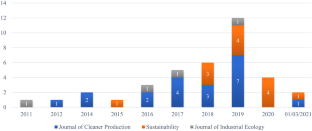
Source: Authors’ elaborations. Notes: The graph shows the time distribution of articles from the three major journals

Source: Authors’ elaboration. Notes: The graph shows the composition of the sample according to the three clusters identified by the analysis
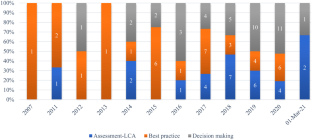
Source: Authors’ elaboration. Notes: The graph shows the distribution of articles over time by cluster
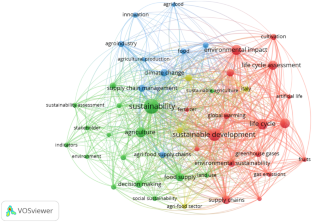
Source: Authors’ elaboration. Notes: The graph shows the network visualization
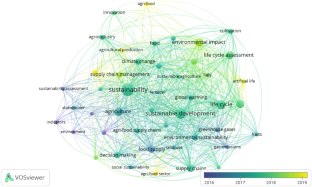
Source: Authors’ elaboration. Notes: The graph shows the overlay visualization
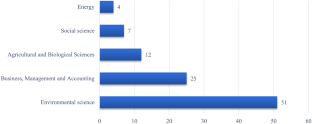
Source: Authors’ elaboration. Notes: The graph shows the classification of articles by scientific field
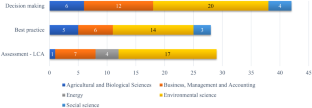
Source: Authors’ elaboration. Notes: Article classification based on their cluster to which they belong and scientific field

Source: Authors’ elaboration
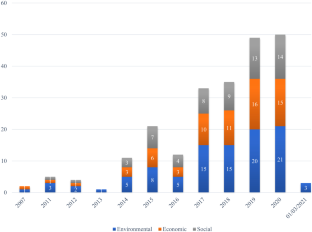
Source: Authors’ elaboration. Notes: The graph shows the distribution of items over time based on TBL
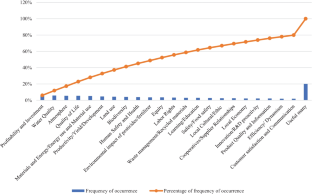
Source: Authors’ elaboration. Notes: The graph shows the Pareto diagram highlighting the most used indicators in literature for measuring sustainability in the agri-food sector
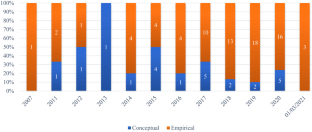
Source: Authors’ elaboration. Notes: The graph shows the distribution over time of articles divided into conceptual and empirical
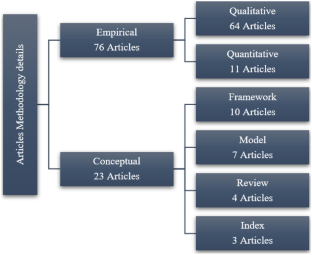
Source: Authors’ elaboration. Notes: The graph shows the classification of articles, divided into conceptual and empirical, in-depth analysis
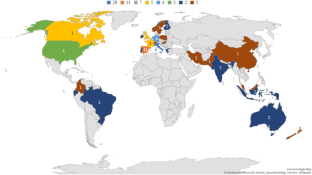
Source: Authors’ elaboration. Notes: The graph shows the geographical distribution of the authors
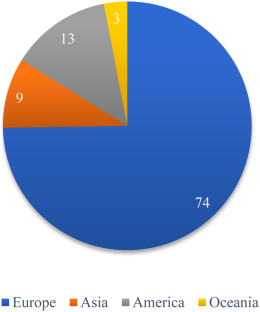
Source: Authors’ elaboration. Notes: The graph shows the distribution of authors according to the continent from which they originate
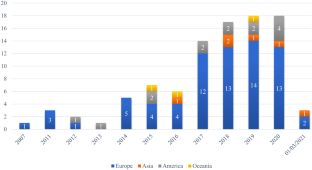
Source: Authors’ elaboration. Notes: The graph shows the time distribution of publication of authors according to the continent from which they originate
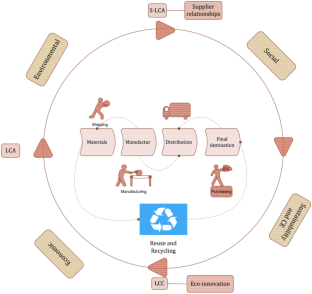
Source: Authors’ elaboration. Notes: Sustainability measurement indicators and impact categories of LCA, S-LCA, and LCC tools should be integrated in order to provide stakeholders with best practices as guidelines and tools to support both decision-making and measurement, according to the circular economy approach
Similar content being viewed by others

Common Methods and Sustainability Indicators

Transition heuristic frameworks in research on agro-food sustainability transitions
Hamid El Bilali
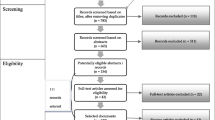
Research on agro-food sustainability transitions: where are food security and nutrition?
Change history, 24 march 2022.
A Correction to this paper has been published: https://doi.org/10.1007/s11367-022-02038-9
Acero AP, Rodriguez C, Ciroth A (2017) LCIA methods: impact assessment methods in life cycle assessment and their impact categories. Version 1.5.6. Green Delta 1–23
Accorsi R, Versari L, Manzini R (2015) Glass vs. plastic: Life cycle assessment of extra-virgin olive oil bottles across global supply chains. Sustain 7:2818–2840. https://doi.org/10.3390/su7032818
Adjei-Bamfo P, Maloreh-Nyamekye T, Ahenkan A (2019) The role of e-government in sustainable public procurement in developing countries: a systematic literature review. Resour Conserv Recycl 142:189–203. https://doi.org/10.1016/j.resconrec.2018.12.001
Article Google Scholar
Aivazidou E, Tsolakis N, Vlachos D, Iakovou E (2015) Water footprint management policies for agrifood supply chains: a critical taxonomy and a system dynamics modelling approach. Chem Eng Trans 43:115–120. https://doi.org/10.3303/CET1543020
Alhaddi H (2015) Triple bottom line and sustainability: a literature review. Bus Manag Stud 1:6–10
Allaoui H, Guo Y, Sarkis J (2019) Decision support for collaboration planning in sustainable supply chains. J Clean Prod 229:761–774. https://doi.org/10.1016/j.jclepro.2019.04.367
Alshqaqeeq F, Amin Esmaeili M, Overcash M, Twomey J (2020) Quantifying hospital services by carbon footprint: a systematic literature review of patient care alternatives. Resour Conserv Recycl 154:104560. https://doi.org/10.1016/j.resconrec.2019.104560
Anwar F, Chaudhry FN, Nazeer S et al (2016) Causes of ozone layer depletion and its effects on human: review. Atmos Clim Sci 06:129–134. https://doi.org/10.4236/acs.2016.61011
Aquilani B, Silvestri C, Ruggieri A (2016). A Systematic Literature Review on Total Quality Management Critical Success Factors and the Identification of New Avenues of Research. https://doi.org/10.1108/TQM-01-2016-0003
Aramyan L, Hoste R, Van Den Broek W et al (2011) Towards sustainable food production: a scenario study of the European pork sector. J Chain Netw Sci 11:177–189. https://doi.org/10.3920/JCNS2011.Qpork8
Arfini F, Antonioli F, Cozzi E et al (2019) Sustainability, innovation and rural development: the case of Parmigiano-Reggiano PDO. Sustain 11:1–17. https://doi.org/10.3390/su11184978
Assembly UG (2005) Resolution adopted by the general assembly. New York, NY
Avilés-Palacios C, Rodríguez-Olalla A (2021) The sustainability of waste management models in circular economies. Sustain 13:1–19. https://doi.org/10.3390/su13137105
Azevedo SG, Silva ME, Matias JCO, Dias GP (2018) The influence of collaboration initiatives on the sustainability of the cashew supply chain. Sustain 10:1–29. https://doi.org/10.3390/su10062075
Bajaj S, Garg R, Sethi M (2016) Total quality management: a critical literature review using Pareto analysis. Int J Product Perform Manag 67:128–154
Banasik A, Kanellopoulos A, Bloemhof-Ruwaard JM, Claassen GDH (2019) Accounting for uncertainty in eco-efficient agri-food supply chains: a case study for mushroom production planning. J Clean Prod 216:249–256. https://doi.org/10.1016/j.jclepro.2019.01.153
Barth H, Ulvenblad PO, Ulvenblad P (2017) Towards a conceptual framework of sustainable business model innovation in the agri-food sector: a systematic literature review. Sustain 9. https://doi.org/10.3390/su9091620
Bastas A, Liyanage K (2018) Sustainable supply chain quality management: a systematic review
Beckerman W (1992) Economic growth and the environment: whose growth? Whose environment? World Dev 20:481–496. https://doi.org/10.1016/0305-750X(92)90038-W
Belaud JP, Prioux N, Vialle C, Sablayrolles C (2019) Big data for agri-food 4.0: application to sustainability management for by-products supply chain. Comput Ind 111:41–50. https://doi.org/10.1016/j.compind.2019.06.006
Bele B, Norderhaug A, Sickel H (2018) Localized agri-food systems and biodiversity. Agric 8. https://doi.org/10.3390/agriculture8020022
Bilali H El, Calabrese G, Iannetta M et al (2020) Environmental sustainability of typical agro-food products: a scientifically sound and user friendly approach. New Medit 19:69–83. https://doi.org/10.30682/nm2002e
Blanc S, Massaglia S, Brun F et al (2019) Use of bio-based plastics in the fruit supply chain: an integrated approach to assess environmental, economic, and social sustainability. Sustain 11. https://doi.org/10.3390/su11092475
Bloemhof JM, van der Vorst JGAJ, Bastl M, Allaoui H (2015) Sustainability assessment of food chain logistics. Int J Logist Res Appl 18:101–117. https://doi.org/10.1080/13675567.2015.1015508
Bonisoli L, Galdeano-Gómez E, Piedra-Muñoz L (2018) Deconstructing criteria and assessment tools to build agri-sustainability indicators and support farmers’ decision-making process. J Clean Prod 182:1080–1094. https://doi.org/10.1016/j.jclepro.2018.02.055
Bonisoli L, Galdeano-Gómez E, Piedra-Muñoz L, Pérez-Mesa JC (2019) Benchmarking agri-food sustainability certifications: evidences from applying SAFA in the Ecuadorian banana agri-system. J Clean Prod 236. https://doi.org/10.1016/j.jclepro.2019.07.054
Bornmann L, Haunschild R, Hug SE (2018) Visualizing the context of citations referencing papers published by Eugene Garfield: a new type of keyword co-occurrence analysis. Scientometrics 114:427–437. https://doi.org/10.1007/s11192-017-2591-8
Boulding KE (1966) The economics of the coming spaceship earth. New York, 1-17
Bracquené E, Dewulf W, Duflou JR (2020) Measuring the performance of more circular complex product supply chains. Resour Conserv Recycl 154:104608. https://doi.org/10.1016/j.resconrec.2019.104608
Burck J, Hagen U, Bals C et al (2021) Climate Change Performance Index
Calisto Friant M, Vermeulen WJV, Salomone R (2020) A typology of circular economy discourses: navigating the diverse visions of a contested paradigm. Resour Conserv Recycl 161:104917. https://doi.org/10.1016/j.resconrec.2020.104917
Campbell BM, Beare DJ, Bennett EM et al (2017) Agriculture production as a major driver of the earth system exceeding planetary boundaries. Ecol Soc 22. https://doi.org/10.5751/ES-09595-220408
Capitanio F, Coppola A, Pascucci S (2010) Product and process innovation in the Italian food industry. Agribusiness 26:503–518. https://doi.org/10.1002/agr.20239
Caputo P, Zagarella F, Cusenza MA et al (2020) Energy-environmental assessment of the UIA-OpenAgri case study as urban regeneration project through agriculture. Sci Total Environ 729:138819. https://doi.org/10.1016/j.scitotenv.2020.138819
Article CAS Google Scholar
Chabowski BR, Mena JA, Gonzalez-Padron TL (2011) The structure of sustainability research in marketing, 1958–2008: a basis for future research opportunities. J Acad Mark Sci 39:55–70. https://doi.org/10.1007/s11747-010-0212-7
Chadegani AA, Salehi H, Yunus M et al (2017) A comparison between two main academic literature collections : Web of Science and Scopus databases. Asian Soc Sci 9:18–26. https://doi.org/10.5539/ass.v9n5p18
Chams N, Guesmi B, Gil JM (2020) Beyond scientific contribution: assessment of the societal impact of research and innovation to build a sustainable agri-food sector. J Environ Manage 264. https://doi.org/10.1016/j.jenvman.2020.110455
Chandrakumar C, McLaren SJ, Jayamaha NP, Ramilan T (2019) Absolute sustainability-based life cycle assessment (ASLCA): a benchmarking approach to operate agri-food systems within the 2°C global carbon budget. J Ind Ecol 23:906–917. https://doi.org/10.1111/jiec.12830
Chaparro-Africano AM (2019) Toward generating sustainability indicators for agroecological markets. Agroecol Sustain Food Syst 43:40–66. https://doi.org/10.1080/21683565.2019.1566192
Colicchia C, Strozzi F (2012) Supply chain risk management: a new methodology for a systematic literature review
Conca L, Manta F, Morrone D, Toma P (2021) The impact of direct environmental, social, and governance reporting: empirical evidence in European-listed companies in the agri-food sector. Bus Strateg Environ 30:1080–1093. https://doi.org/10.1002/bse.2672
Coppola A, Ianuario S, Romano S, Viccaro M (2020) Corporate social responsibility in agri-food firms: the relationship between CSR actions and firm’s performance. AIMS Environ Sci 7:542–558. https://doi.org/10.3934/environsci.2020034
Corona B, Shen L, Reike D et al (2019) Towards sustainable development through the circular economy—a review and critical assessment on current circularity metrics. Resour Conserv Recycl 151:104498. https://doi.org/10.1016/j.resconrec.2019.104498
Correia MS (2019) Sustainability: An overview of the triple bottom line and sustainability implementation. Int J Strateg Eng 2:29–38. https://doi.org/10.4018/IJoSE.2019010103
Coteur I, Marchand F, Debruyne L, Lauwers L (2019) Structuring the myriad of sustainability assessments in agri-food systems: a case in Flanders. J Clean Prod 209:472–480. https://doi.org/10.1016/j.jclepro.2018.10.066
CREA (2020) L’agricoltura italiana conta 2019
Crenna E, Sala S, Polce C, Collina E (2017) Pollinators in life cycle assessment: towards a framework for impact assessment. J Clean Prod 140:525–536. https://doi.org/10.1016/j.jclepro.2016.02.058
D’Eusanio M, Serreli M, Zamagni A, Petti L (2018) Assessment of social dimension of a jar of honey: a methodological outline. J Clean Prod 199:503–517. https://doi.org/10.1016/j.jclepro.2018.07.157
Dania WAP, Xing K, Amer Y (2018) Collaboration behavioural factors for sustainable agri-food supply chains: a systematic review. J Clean Prod 186:851–864
De Pascale A, Arbolino R, Szopik-Depczyńska K et al (2021) A systematic review for measuring circular economy: the 61 indicators. J Clean Prod 281. https://doi.org/10.1016/j.jclepro.2020.124942
De Schoenmakere M, Gillabel J (2017) Circular by design: products in the circular economy
Del Borghi A, Gallo M, Strazza C, Del Borghi M (2014) An evaluation of environmental sustainability in the food industry through life cycle assessment: the case study of tomato products supply chain. J Clean Prod 78:121–130. https://doi.org/10.1016/j.jclepro.2014.04.083
Del Borghi A, Strazza C, Magrassi F et al (2018) Life cycle assessment for eco-design of product–package systems in the food industry—the case of legumes. Sustain Prod Consum 13:24–36. https://doi.org/10.1016/j.spc.2017.11.001
Denyer D, Tranfield D (2009) Producing a systematic review. In: Buchanan B (ed) The sage handbook of organization research methods. Sage Publications Ltd, Cornwall, pp 671–689
Google Scholar
Dietz T, Grabs J, Chong AE (2019) Mainstreamed voluntary sustainability standards and their effectiveness: evidence from the Honduran coffee sector. Regul Gov. https://doi.org/10.1111/rego.12239
Dixon-Woods M (2011) Using framework-based synthesis for conducting reviews of qualitative studies. BMC Med 9:9–10. https://doi.org/10.1186/1741-7015-9-39
do Canto NR, Bossle MB, Marques L, Dutra M, (2020) Supply chain collaboration for sustainability: a qualitative investigation of food supply chains in Brazil. Manag Environ Qual an Int J. https://doi.org/10.1108/MEQ-12-2019-0275
dos Santos RR, Guarnieri P (2020) Social gains for artisanal agroindustrial producers induced by cooperation and collaboration in agri-food supply chain. Soc Responsib J. https://doi.org/10.1108/SRJ-09-2019-0323
Doukidis GI, Matopoulos A, Vlachopoulou M, Manthou V, Manos B (2007) A conceptual framework for supply chain collaboration: empirical evidence from the agri‐food industry. Supply Chain Manag an Int Journal 12:177–186. https://doi.org/10.1108/13598540710742491
Durach CF, Kembro J, Wieland A (2017) A new paradigm for systematic literature reviews in supply chain management. J Supply Chain Manag 53:67–85. https://doi.org/10.1111/jscm.12145
Durán-Sánchez A, Álvarez-García J, Río-Rama D, De la Cruz M (2018) Sustainable water resources management: a bibliometric overview. Water 10:1–19. https://doi.org/10.3390/w10091191
Duru M, Therond O (2015) Livestock system sustainability and resilience in intensive production zones: which form of ecological modernization? Reg Environ Chang 15:1651–1665. https://doi.org/10.1007/s10113-014-0722-9
Edison Fondazione (2019) Le eccellenze agricole italiane. I primati europei e mondiali dell’Italia nei prodotti vegetali. Milan (IT)
Ehrenfeld JR (2005) The roots of sustainability. MIT Sloan Manag Rev 46(2)46:23–25
Elia V, Gnoni MG, Tornese F (2017) Measuring circular economy strategies through index methods: a critical analysis. J Clean Prod 142:2741–2751. https://doi.org/10.1016/j.jclepro.2016.10.196
Elkington J (1997) Cannibals with forks : the triple bottom line of 21st century business. Capstone, Oxford
Esposito B, Sessa MR, Sica D, Malandrino O (2020) Towards circular economy in the agri-food sector. A systematic literature review. Sustain 12. https://doi.org/10.3390/SU12187401
European Commission (2018) Agri-food trade in 2018
European Commission (2019) Monitoring EU agri-food trade: development until September 2019
Eurostat (2018) Small and large farms in the EU - statistics from the farm structure survey
FAO (2011) Biodiversity for food and agriculture. Italy, Rome
FAO (2012) Energy-smart food at FAO: an overview. Italy, Rome
FAO (2014) Food wastage footprint: fool cost-accounting
FAO (2016) The state of food and agriculture climate change, agriculture and food security. Italy, Rome
FAO (2017) The future of food and agriculture: trends and challenges. Italy, Rome
FAO (2020) The state of food security and nutrition in the world. Transforming Food Systems for Affordable Healthy Diets. Rome, Italy
Fassio F, Tecco N (2019) Circular economy for food: a systemic interpretation of 40 case histories in the food system in their relationships with SDGs. Systems 7:43. https://doi.org/10.3390/systems7030043
Fathollahi A, Coupe SJ (2021) Life cycle assessment (LCA) and life cycle costing (LCC) of road drainage systems for sustainability evaluation: quantifying the contribution of different life cycle phases. Sci Total Environ 776:145937. https://doi.org/10.1016/j.scitotenv.2021.145937
Ferreira VJ, Arnal ÁJ, Royo P et al (2019) Energy and resource efficiency of electroporation-assisted extraction as an emerging technology towards a sustainable bio-economy in the agri-food sector. J Clean Prod 233:1123–1132. https://doi.org/10.1016/j.jclepro.2019.06.030
Fiksel J (2006) A framework for sustainable remediation. JOM 8:15–22. https://doi.org/10.1021/es202595w
Flick U (2014) An introduction to qualitative research
Franciosi C, Voisin A, Miranda S et al (2020) Measuring maintenance impacts on sustainability of manufacturing industries : from a systematic literature review to a framework proposal. J Clean Prod 260:1–19. https://doi.org/10.1016/j.jclepro.2020.121065
Gaitán-Cremaschi D, Meuwissen MPM, Oude AGJML (2017) Total factor productivity: a framework for measuring agri-food supply chain performance towards sustainability. Appl Econ Perspect Policy 39:259–285. https://doi.org/10.1093/aepp/ppw008
Galdeano-Gómez E, Zepeda-Zepeda JA, Piedra-Muñoz L, Vega-López LL (2017) Family farm’s features influencing socio-economic sustainability: an analysis of the agri-food sector in southeast Spain. New Medit 16:50–61
Gallopín G, Herrero LMJ, Rocuts A (2014) Conceptual frameworks and visual interpretations of sustainability. Int J Sustain Dev 17:298–326. https://doi.org/10.1504/IJSD.2014.064183
Gallopín GC (2003) Sostenibilidad y desarrollo sostenible: un enfoque sistémico. Cepal, LATIN AMERICA
Garnett T (2013) Food sustainability: problems, perspectives and solutions. Proc Nutr Soc 72:29–39. https://doi.org/10.1017/S0029665112002947
Garofalo P, D’Andrea L, Tomaiuolo M et al (2017) Environmental sustainability of agri-food supply chains in Italy: the case of the whole-peeled tomato production under life cycle assessment methodology. J Food Eng 200:1–12. https://doi.org/10.1016/j.jfoodeng.2016.12.007
Gava O, Bartolini F, Venturi F et al (2018) A reflection of the use of the life cycle assessment tool for agri-food sustainability. Sustain 11. https://doi.org/10.3390/su11010071
Gazzola P, Querci E (2017) The connection between the quality of life and sustainable ecological development. Eur Sci J 7881:1857–7431
Geissdoerfer M, Savaget P, Bocken N, Hultink EJ (2017) The circular economy – a new sustainability paradigm ? The circular economy – a new sustainability paradigm ? J Clean Prod 143:757–768. https://doi.org/10.1016/j.jclepro.2016.12.048
Georgescu-Roegen N (1971) The entropy low and the economic process. Harward University Press, Cambridge Mass
Book Google Scholar
Gerbens-Leenes PW, Moll HC, Schoot Uiterkamp AJM (2003) Design and development of a measuring method for environmental sustainability in food production systems. Ecol Econ 46:231–248. https://doi.org/10.1016/S0921-8009(03)00140-X
Gésan-Guiziou G, Alaphilippe A, Aubin J et al (2020) Diversity and potentiality of multi-criteria decision analysis methods for agri-food research. Agron Sustain Dev 40. https://doi.org/10.1007/s13593-020-00650-3
Ghisellini P, Cialani C, Ulgiati S (2016) A review on circular economy: the expected transition to a balanced interplay of environmental and economic systems. J Clean Prod 114:11–32. https://doi.org/10.1016/j.jclepro.2015.09.007
Godoy-Durán Á, Galdeano- Gómez E, Pérez-Mesa JC, Piedra-Muñoz L (2017) Assessing eco-efficiency and the determinants of horticultural family-farming in southeast Spain. J Environ Manage 204:594–604. https://doi.org/10.1016/j.jenvman.2017.09.037
Gold S, Kunz N, Reiner G (2017) Sustainable global agrifood supply chains: exploring the barriers. J Ind Ecol 21:249–260. https://doi.org/10.1111/jiec.12440
Goucher L, Bruce R, Cameron DD et al (2017) The environmental impact of fertilizer embodied in a wheat-to-bread supply chain. Nat Plants 3:1–5. https://doi.org/10.1038/nplants.2017.12
Green A, Nemecek T, Chaudhary A, Mathys A (2020) Assessing nutritional, health, and environmental sustainability dimensions of agri-food production. Glob Food Sec 26:100406. https://doi.org/10.1016/j.gfs.2020.100406
Guinée JB, Heijungs R, Huppes G et al (2011) Life cycle assessment: past, present, and future †. Environ Sci Technol 45:90–96. https://doi.org/10.1021/es101316v
Guiomar N, Godinho S, Pinto-Correia T et al (2018) Typology and distribution of small farms in Europe: towards a better picture. Land Use Policy 75:784–798. https://doi.org/10.1016/j.landusepol.2018.04.012
Gunasekaran A, Patel C, McGaughey RE (2004) A framework for supply chain performance measurement. Int J Prod Econ 87:333–347. https://doi.org/10.1016/j.ijpe.2003.08.003
Gunasekaran A, Patel C, Tirtiroglu E (2001) Performance measures and metrics in a supply chain environment. Int J Oper Prod Manag 21:71–87. https://doi.org/10.1108/01443570110358468
Hamam M, Chinnici G, Di Vita G et al (2021) Circular economy models in agro-food systems: a review. Sustain 13
Harun SN, Hanafiah MM, Aziz NIHA (2021) An LCA-based environmental performance of rice production for developing a sustainable agri-food system in Malaysia. Environ Manage 67:146–161. https://doi.org/10.1007/s00267-020-01365-7
Harvey M, Pilgrim S (2011) The new competition for land: food, energy, and climate change. Food Policy 36:S40–S51. https://doi.org/10.1016/j.foodpol.2010.11.009
Hawkes C, Ruel MT (2006) Understanding the links between agriculture and health. DC: International Food Policy Research Institute. Washington, USA
Hellweg S, Milà i Canals L (2014) Emerging approaches, challenges and opportunities in life cycle assessment. Science (80)344:1109LP–1113. https://doi.org/10.1126/science.1248361
Higgins V, Dibden J, Cocklin C (2015) Private agri-food governance and greenhouse gas abatement: constructing a corporate carbon economy. Geoforum 66:75–84. https://doi.org/10.1016/j.geoforum.2015.09.012
Hill T (1995) Manufacturing strategy: text and cases., Macmillan
Hjeresen DD, Gonzales R (2020) Green chemistry promote sustainable agriculture?The rewards are higher yields and less environmental contamination. Environemental Sci Techonology 103–107
Horne R, Grant T, Verghese K (2009) Life cycle assessment: principles, practice, and prospects. Csiro Publishing, Collingwood, Australia
Horton P, Koh L, Guang VS (2016) An integrated theoretical framework to enhance resource efficiency, sustainability and human health in agri-food systems. J Clean Prod 120:164–169. https://doi.org/10.1016/j.jclepro.2015.08.092
Hospido A, Davis J, Berlin J, Sonesson U (2010) A review of methodological issues affecting LCA of novel food products. Int J Life Cycle Assess 15:44–52. https://doi.org/10.1007/s11367-009-0130-4
Huffman T, Liu J, Green M et al (2015) Improving and evaluating the soil cover indicator for agricultural land in Canada. Ecol Indic 48:272–281. https://doi.org/10.1016/j.ecolind.2014.07.008
Ilbery B, Maye D (2005) Food supply chains and sustainability: evidence from specialist food producers in the Scottish/English borders. Land Use Policy 22:331–344. https://doi.org/10.1016/j.landusepol.2004.06.002
Ingrao C, Faccilongo N, Valenti F et al (2019) Tomato puree in the Mediterranean region: an environmental life cycle assessment, based upon data surveyed at the supply chain level. J Clean Prod 233:292–313. https://doi.org/10.1016/j.jclepro.2019.06.056
Iocola I, Angevin F, Bockstaller C et al (2020) An actor-oriented multi-criteria assessment framework to support a transition towards sustainable agricultural systems based on crop diversification. Sustain 12. https://doi.org/10.3390/su12135434
Irabien A, Darton RC (2016) Energy–water–food nexus in the Spanish greenhouse tomato production. Clean Technol Environ Policy 18:1307–1316. https://doi.org/10.1007/s10098-015-1076-9
ISO 14040:2006 (2006) Environmental management — life cycle assessment — principles and framework
ISO 14044:2006 (2006) Environmental management — life cycle assessment — requirements and guidelines
ISO 15392:2008 (2008) Sustainability in building construction–general principles
Istat (2019) Andamento dell’economia agricola
Jaakkola E (2020) Designing conceptual articles : four approaches. AMS Rev 1–9. https://doi.org/10.1007/s13162-020-00161-0
Jin R, Yuan H, Chen Q (2019) Science mapping approach to assisting the review of construction and demolition waste management research published between 2009 and 2018. Resour Conserv Recycl 140:175–188. https://doi.org/10.1016/j.resconrec.2018.09.029
Johnston P, Everard M, Santillo D, Robèrt KH (2007) Reclaiming the definition of sustainability. Environ Sci Pollut Res Int 14:60–66. https://doi.org/10.1065/espr2007.01.375
Jorgensen SE, Burkhard B, Müller F (2013) Twenty volumes of ecological indicators-an accounting short review. Ecol Indic 28:4–9. https://doi.org/10.1016/j.ecolind.2012.12.018
Joshi S, Sharma M, Kler R (2020) Modeling circular economy dimensions in agri-tourism clusters: sustainable performance and future research directions. Int J Math Eng Manag Sci 5:1046–1061. https://doi.org/10.33889/IJMEMS.2020.5.6.080
Kamilaris A, Gao F, Prenafeta-Boldu FX, Ali MI (2017) Agri-IoT: a semantic framework for Internet of Things-enabled smart farming applications. In: 2016 IEEE 3rd World Forum on Internet of Things, WF-IoT 2016. pp 442–447
Karuppusami G, Gandhinathan R (2006) Pareto analysis of critical success factors of total quality management: a literature review and analysis. TQM Mag 18:372–385. https://doi.org/10.1108/09544780610671048
Kates RW, Parris TM, Leiserowitz AA (2005) What is sustainable development? Goals, indicators, values, and practice. Environ Sci Policy Sustain Dev 47:8–21. https://doi.org/10.1080/00139157.2005.10524444
Khounani Z, Hosseinzadeh-Bandbafha H, Moustakas K et al (2021) Environmental life cycle assessment of different biorefinery platforms valorizing olive wastes to biofuel, phosphate salts, natural antioxidant, and an oxygenated fuel additive (triacetin). J Clean Prod 278:123916. https://doi.org/10.1016/j.jclepro.2020.123916
Kitchenham B, Charters S (2007) Guidelines for performing systematic literature reviews in software engineering version 2.3. Engineering 45. https://doi.org/10.1145/1134285.1134500
Korhonen J, Nuur C, Feldmann A, Birkie SE (2018) Circular economy as an essentially contested concept. J Clean Prod 175:544–552. https://doi.org/10.1016/j.jclepro.2017.12.111
Kuisma M, Kahiluoto H (2017) Biotic resource loss beyond food waste: agriculture leaks worst. Resour Conserv Recycl 124:129–140. https://doi.org/10.1016/j.resconrec.2017.04.008
Laso J, Hoehn D, Margallo M et al (2018) Assessing energy and environmental efficiency of the Spanish agri-food system using the LCA/DEA methodology. Energies 11. https://doi.org/10.3390/en11123395
Lee KM (2007) So What is the “triple bottom line”? Int J Divers Organ Communities Nations Annu Rev 6:67–72. https://doi.org/10.18848/1447-9532/cgp/v06i06/39283
Lehmann RJ, Hermansen JE, Fritz M et al (2011) Information services for European pork chains - closing gaps in information infrastructures. Comput Electron Agric 79:125–136. https://doi.org/10.1016/j.compag.2011.09.002
León-Bravo V, Caniato F, Caridi M, Johnsen T (2017) Collaboration for sustainability in the food supply chain: a multi-stage study in Italy. Sustainability 9:1253
Lepage A (2009) The quality of life as attribute of sustainability. TQM J 21:105–115. https://doi.org/10.1108/17542730910938119
Li CZ, Zhao Y, Xiao B et al (2020) Research trend of the application of information technologies in construction and demolition waste management. J Clean Prod 263. https://doi.org/10.1016/j.jclepro.2020.121458
Lo Giudice A, Mbohwa C, Clasadonte MT, Ingrao C (2014) Life cycle assessment interpretation and improvement of the Sicilian artichokes production. Int J Environ Res 8:305–316. https://doi.org/10.22059/ijer.2014.721
Lueddeckens S, Saling P, Guenther E (2020) Temporal issues in life cycle assessment—a systematic review. Int J Life Cycle Assess 25:1385–1401. https://doi.org/10.1007/s11367-020-01757-1
Luo J, Ji C, Qiu C, Jia F (2018) Agri-food supply chain management: bibliometric and content analyses. Sustain 10. https://doi.org/10.3390/su10051573
Lynch J, Donnellan T, Finn JA et al (2019) Potential development of Irish agricultural sustainability indicators for current and future policy evaluation needs. J Environ Manage 230:434–445. https://doi.org/10.1016/j.jenvman.2018.09.070
MacArthur E (2013) Towards the circular economy. J Ind Ecol 2:23–44
MacArthur E (2017) Delivering the circular economy a toolkit for policymakers, The Ellen MacArthur Foundation
MacInnis DJ (2011) A framework for conceptual. J Mark 75:136–154. https://doi.org/10.1509/jmkg.75.4.136
Mangla SK, Luthra S, Rich N et al (2018) Enablers to implement sustainable initiatives in agri-food supply chains. Int J Prod Econ 203:379–393. https://doi.org/10.1016/j.ijpe.2018.07.012
Marotta G, Nazzaro C, Stanco M (2017) How the social responsibility creates value: models of innovation in Italian pasta industry. Int J Glob Small Bus 9:144–167. https://doi.org/10.1504/IJGSB.2017.088923
Martucci O, Arcese G, Montauti C, Acampora A (2019) Social aspects in the wine sector: comparison between social life cycle assessment and VIVA sustainable wine project indicators. Resources 8. https://doi.org/10.3390/resources8020069
Mayring P (2004) Forum : Qualitative social research Sozialforschung 2. History of content analysis. A Companion to Qual Res 1:159–176
McKelvey B (2002) Managing coevolutionary dynamics. In: 18th EGOS Conference. Barcelona, Spain, pp 1–21
McMichael AJ, Butler CD, Folke C (2003) New visions for addressing sustainability. Science (80- ) 302:1191–1920
Mehmood A, Ahmed S, Viza E et al (2021) Drivers and barriers towards circular economy in agri-food supply chain: a review. Bus Strateg Dev 1–17. https://doi.org/10.1002/bsd2.171
Mella P, Gazzola P (2011) Sustainability and quality of life: the development model. In: Kapounek S (ed) Enterprise and competitive environment. Mendel University: Brno, Czechia. 542–551
Merli R, Preziosi M, Acampora A (2018) How do scholars approach the circular economy ? A systematic literature review. J Clean Prod 178:703–722. https://doi.org/10.1016/j.jclepro.2017.12.112
Merli R, Preziosi M, Acampora A et al (2020) Recycled fibers in reinforced concrete: a systematic literature review. J Clean Prod 248:119207. https://doi.org/10.1016/j.jclepro.2019.119207
Miglietta PP, Morrone D (2018) Managing water sustainability: virtual water flows and economic water productivity assessment of the wine trade between Italy and the Balkans. Sustain 10. https://doi.org/10.3390/su10020543
Mitchell MGE, Chan KMA, Newlands NK, Ramankutty N (2020) Spatial correlations don’t predict changes in agricultural ecosystem services: a Canada-wide case study. Front Sustain Food Syst 4:1–17. https://doi.org/10.3389/fsufs.2020.539892
Moraga G, Huysveld S, Mathieux F et al (2019) Circular economy indicators: what do they measure?. Resour Conserv Recycl 146:452–461. https://doi.org/10.1016/j.resconrec.2019.03.045
Morrissey JE, Dunphy NP (2015) Towards sustainable agri-food systems: the role of integrated sustainability and value assessment across the supply-chain. Int J Soc Ecol Sustain Dev 6:41–58. https://doi.org/10.4018/IJSESD.2015070104
Moser G (2009) Quality of life and sustainability: toward person-environment congruity. J Environ Psychol 29:351–357. https://doi.org/10.1016/j.jenvp.2009.02.002
Muijs D (2010) Doing quantitative research in education with SPSS. London
Muller MF, Esmanioto F, Huber N, Loures ER (2019) A systematic literature review of interoperability in the green Building Information Modeling lifecycle. J Clean Prod 223:397–412. https://doi.org/10.1016/j.jclepro.2019.03.114
Muradin M, Joachimiak-Lechman K, Foltynowicz Z (2018) Evaluation of eco-efficiency of two alternative agricultural biogas plants. Appl Sci 8. https://doi.org/10.3390/app8112083
Naseer MA, ur R, Ashfaq M, Hassan S, et al (2019) Critical issues at the upstream level in sustainable supply chain management of agri-food industries: evidence from Pakistan’s citrus industry. Sustain 11:1–19. https://doi.org/10.3390/su11051326
Nattassha R, Handayati Y, Simatupang TM, Siallagan M (2020) Understanding circular economy implementation in the agri-food supply chain: the case of an Indonesian organic fertiliser producer. Agric Food Secur 9:1–16. https://doi.org/10.1186/s40066-020-00264-8
Nazari-Sharabian M, Ahmad S, Karakouzian M (2018) Climate change and eutrophication: a short review. Eng Technol Appl Sci Res 8:3668–3672. https://doi.org/10.5281/zenodo.2532694
Nazir N (2017) Understanding life cycle thinking and its practical application to agri-food system. Int J Adv Sci Eng Inf Technol 7:1861–1870. https://doi.org/10.18517/ijaseit.7.5.3578
Negra C, Remans R, Attwood S et al (2020) Sustainable agri-food investments require multi-sector co-development of decision tools. Ecol Indic 110:105851. https://doi.org/10.1016/j.ecolind.2019.105851
Newsham KK, Robinson SA (2009) Responses of plants in polar regions to UVB exposure: a meta-analysis. Glob Chang Biol 15:2574–2589. https://doi.org/10.1111/j.1365-2486.2009.01944.x
Niemeijer D, de Groot RS (2008) A conceptual framework for selecting environmental indicator sets. Ecol Indic 8:14–25. https://doi.org/10.1016/j.ecolind.2006.11.012
Niero M, Kalbar PP (2019) Coupling material circularity indicators and life cycle based indicators: a proposal to advance the assessment of circular economy strategies at the product level. Resour Conserv Recycl 140:305–312. https://doi.org/10.1016/j.resconrec.2018.10.002
Nikolaou IE, Tsagarakis KP (2021) An introduction to circular economy and sustainability: some existing lessons and future directions. Sustain Prod Consum 28:600–609. https://doi.org/10.1016/j.spc.2021.06.017
Notarnicola B, Hayashi K, Curran MA, Huisingh D (2012) Progress in working towards a more sustainable agri-food industry. J Clean Prod 28:1–8. https://doi.org/10.1016/j.jclepro.2012.02.007
Notarnicola B, Tassielli G, Renzulli PA, Monforti F (2017) Energy flows and greenhouses gases of EU (European Union) national breads using an LCA (life cycle assessment) approach. J Clean Prod 140:455–469. https://doi.org/10.1016/j.jclepro.2016.05.150
Opferkuch K, Caeiro S, Salomone R, Ramos TB (2021) Circular economy in corporate sustainability reporting: a review of organisational approaches. Bus Strateg Environ 1–22. https://doi.org/10.1002/bse.2854
Padilla-Rivera A, do Carmo BBT, Arcese G, Merveille N, (2021) Social circular economy indicators: selection through fuzzy delphi method. Sustain Prod Consum 26:101–110. https://doi.org/10.1016/j.spc.2020.09.015
Pagotto M, Halog A (2016) Towards a circular economy in Australian agri-food industry: an application of input-output oriented approaches for analyzing resource efficiency and competitiveness potential. J Ind Ecol 20:1176–1186. https://doi.org/10.1111/jiec.12373
Parent G, Lavallée S (2011) LCA potentials and limits within a sustainable agri-food statutory framework. Global food insecurity. Springer, Netherlands, Dordrecht, pp 161–171
Chapter Google Scholar
Pattey E, Qiu G (2012) Trends in primary particulate matter emissions from Canadian agriculture. J Air Waste Manag Assoc 62:737–747. https://doi.org/10.1080/10962247.2012.672058
Pauliuk S (2018) Critical appraisal of the circular economy standard BS 8001:2017 and a dashboard of quantitative system indicators for its implementation in organizations. Resour Conserv Recycl 129:81–92. https://doi.org/10.1016/j.resconrec.2017.10.019
Peano C, Migliorini P, Sottile F (2014) A methodology for the sustainability assessment of agri-food systems: an application to the slow food presidia project. Ecol Soc 19. https://doi.org/10.5751/ES-06972-190424
Peano C, Tecco N, Dansero E et al (2015) Evaluating the sustainability in complex agri-food systems: the SAEMETH framework. Sustain 7:6721–6741. https://doi.org/10.3390/su7066721
Pearce DW, Turner RK (1990) Economics of natural resources and the environment. Harvester Wheatsheaf, Hemel Hempstead, Herts
Pelletier N (2018) Social sustainability assessment of Canadian egg production facilities: methods, analysis, and recommendations. Sustain 10:1–17. https://doi.org/10.3390/su10051601
Peña C, Civit B, Gallego-Schmid A et al (2021) Using life cycle assessment to achieve a circular economy. Int J Life Cycle Assess 26:215–220. https://doi.org/10.1007/s11367-020-01856-z
Perez Neira D (2016) Energy sustainability of Ecuadorian cacao export and its contribution to climate change. A case study through product life cycle assessment. J Clean Prod 112:2560–2568. https://doi.org/10.1016/j.jclepro.2015.11.003
Pérez-Neira D, Grollmus-Venegas A (2018) Life-cycle energy assessment and carbon footprint of peri-urban horticulture. A comparative case study of local food systems in Spain. Landsc Urban Plan 172:60–68. https://doi.org/10.1016/j.landurbplan.2018.01.001
Pérez-Pons ME, Plaza-Hernández M, Alonso RS et al (2021) Increasing profitability and monitoring environmental performance: a case study in the agri-food industry through an edge-iot platform. Sustain 13:1–16. https://doi.org/10.3390/su13010283
Petti L, Serreli M, Di Cesare S (2018) Systematic literature review in social life cycle assessment. Int J Life Cycle Assess 23:422–431. https://doi.org/10.1007/s11367-016-1135-4
Pieroni MPP, McAloone TC, Pigosso DCA (2019) Business model innovation for circular economy and sustainability: a review of approaches. J Clean Prod 215:198–216. https://doi.org/10.1016/j.jclepro.2019.01.036
Polit DF, Beck CT (2004) Nursing research: principles and methods. Lippincott Williams & Wilkins, Philadelphia, PA
Porkka M, Gerten D, Schaphoff S et al (2016) Causes and trends of water scarcity in food production. Environ Res Lett 11:015001. https://doi.org/10.1088/1748-9326/11/1/015001
Prajapati H, Kant R, Shankar R (2019) Bequeath life to death: state-of-art review on reverse logistics. J Clean Prod 211:503–520. https://doi.org/10.1016/j.jclepro.2018.11.187
Priyadarshini P, Abhilash PC (2020) Policy recommendations for enabling transition towards sustainable agriculture in India. Land Use Policy 96:104718. https://doi.org/10.1016/j.landusepol.2020.104718
Pronti A, Coccia M (2020) Multicriteria analysis of the sustainability performance between agroecological and conventional coffee farms in the East Region of Minas Gerais (Brazil). Renew Agric Food Syst. https://doi.org/10.1017/S1742170520000332
Rabadán A, González-Moreno A, Sáez-Martínez FJ (2019) Improving firms’ performance and sustainability: the case of eco-innovation in the agri-food industry. Sustain 11. https://doi.org/10.3390/su11205590
Raut RD, Luthra S, Narkhede BE et al (2019) Examining the performance oriented indicators for implementing green management practices in the Indian agro sector. J Clean Prod 215:926–943. https://doi.org/10.1016/j.jclepro.2019.01.139
Recanati F, Marveggio D, Dotelli G (2018) From beans to bar: a life cycle assessment towards sustainable chocolate supply chain. Sci Total Environ 613–614:1013–1023. https://doi.org/10.1016/j.scitotenv.2017.09.187
Redclift M (2005) Sustainable development (1987–2005): an oxymoron comes of age. Sustain Dev 13:212–227. https://doi.org/10.1002/sd.281
Rezaei M, Soheilifard F, Keshvari A (2021) Impact of agrochemical emission models on the environmental assessment of paddy rice production using life cycle assessment approach. Energy Sources. Part A Recover Util Environ Eff 1–16
Rigamonti L, Mancini E (2021) Life cycle assessment and circularity indicators. Int J Life Cycle Assess. https://doi.org/10.1007/s11367-021-01966-2
Risku-Norja H, Mäenpää I (2007) MFA model to assess economic and environmental consequences of food production and consumption. Ecol Econ 60:700–711. https://doi.org/10.1016/j.ecolecon.2006.05.001
Ritzén S, Sandström GÖ (2017) Barriers to the circular economy – integration of perspectives and domains. Procedia CIRP 64:7–12. https://doi.org/10.1016/j.procir.2017.03.005
Rockström J, Steffen W, Noone K et al (2009) A safe operating space for humanity. Nature 461:472–475. https://doi.org/10.1038/461472a
Roos Lindgreen E, Mondello G, Salomone R et al (2021) Exploring the effectiveness of grey literature indicators and life cycle assessment in assessing circular economy at the micro level: a comparative analysis. Int J Life Cycle Assess. https://doi.org/10.1007/s11367-021-01972-4
Roselli L, Casieri A, De Gennaro BC et al (2020) Environmental and economic sustainability of table grape production in Italy. Sustain 12. https://doi.org/10.3390/su12093670
Ross RB, Pandey V, Ross KL (2015) Sustainability and strategy in U.S. agri-food firms: an assessment of current practices. Int Food Agribus Manag Rev 18:17–48
Royo P, Ferreira VJ, López-Sabirón AM, Ferreira G. (2016) Hybrid diagnosis to characterise the energy and environmental enhancement of photovoltaic modules using smart materials. Energy 101:174–189. https://doi.org/10.1016/j.energy.2016.01.101
Ruggerio CA (2021) Sustainability and sustainable development: a review of principles and definitions. Sci Total Environ 786:147481. https://doi.org/10.1016/j.scitotenv.2021.147481
Ruiz-Almeida A, Rivera-Ferre MG (2019) Internationally-based indicators to measure agri-food systems sustainability using food sovereignty as a conceptual framework. Food Secur 11:1321–1337. https://doi.org/10.1007/s12571-019-00964-5
Ryan M, Hennessy T, Buckley C et al (2016) Developing farm-level sustainability indicators for Ireland using the Teagasc National Farm Survey. Irish J Agric Food Res 55:112–125. https://doi.org/10.1515/ijafr-2016-0011
Saade MRM, Yahia A, Amor B (2020) How has LCA been applied to 3D printing ? A systematic literature review and recommendations for future studies. J Clean Prod 244:118803. https://doi.org/10.1016/j.jclepro.2019.118803
Saitone TL, Sexton RJ (2017) Agri-food supply chain: evolution and performance with conflicting consumer and societal demands. Eur Rev Agric Econ 44:634–657. https://doi.org/10.1093/erae/jbx003
Salim N, Ab Rahman MN, Abd Wahab D (2019) A systematic literature review of internal capabilities for enhancing eco-innovation performance of manufacturing firms. J Clean Prod 209:1445–1460. https://doi.org/10.1016/j.jclepro.2018.11.105
Salimi N (2021) Circular economy in agri-food systems BT - strategic decision making for sustainable management of industrial networks. In: International S (ed) Rezaei J. Publishing, Cham, pp 57–70
Salomone R, Ioppolo G (2012) Environmental impacts of olive oil production: a life cycle assessment case study in the province of Messina (Sicily). J Clean Prod 28:88–100. https://doi.org/10.1016/j.jclepro.2011.10.004
Sánchez AD, Río DMDLC, García JÁ (2017) Bibliometric analysis of publications on wine tourism in the databases Scopus and WoS. Eur Res Manag Bus Econ 23:8–15. https://doi.org/10.1016/j.iedeen.2016.02.001
Saputri VHL, Sutopo W, Hisjam M, Ma’aram A (2019) Sustainable agri-food supply chain performance measurement model for GMO and non-GMO using data envelopment analysis method. Appl Sci 9. https://doi.org/10.3390/app9061199
Sassanelli C, Rosa P, Rocca R, Terzi S (2019) Circular economy performance assessment methods : a systematic literature review. J Clean Prod 229:440–453. https://doi.org/10.1016/j.jclepro.2019.05.019
Schiefer S, Gonzalez C, Flanigan S (2015) More than just a factor in transition processes? The role of collaboration in agriculture. In: Sutherland LA, Darnhofer I, Wilson GA, Zagata L (eds) Transition pathways towards sustainability in agriculture: case studies from Europe, CPI Group. Croydon, UK, pp. 83
Seuring S, Muller M (2008) From a literature review to a conceptual framework for sustainable supply chain management. J Clean Prod 16:1699–1710. https://doi.org/10.1016/j.jclepro.2008.04.020
Silvestri C, Silvestri L, Forcina A, et al (2021) Green chemistry contribution towards more equitable global sustainability and greater circular economy: A systematic literature review. J Clean Prod 294. https://doi.org/10.1016/j.jclepro.2021.126137
Smetana S, Schmitt E, Mathys A (2019) Sustainable use of Hermetia illucens insect biomass for feed and food: attributional and consequential life cycle assessment. Resour Conserv Recycl 144:285–296. https://doi.org/10.1016/j.resconrec.2019.01.042
Sonesson U, Berlin J, Ziegler F (2010) Environmental assessment and management in the food industry: life cycle assessment and related approaches. Woodhead Publishing, Cambridge
Soussana JF (2014) Research priorities for sustainable agri-food systems and life cycle assessment. J Clean Prod 73:19–23. https://doi.org/10.1016/j.jclepro.2014.02.061
Soylu A, Oruç C, Turkay M et al (2006) Synergy analysis of collaborative supply chain management in energy systems using multi-period MILP. Eur J Oper Res 174:387–403. https://doi.org/10.1016/j.ejor.2005.02.042
Spaiser V, Ranganathan S, Swain RB, Sumpter DJ (2017) The sustainable development oxymoron: quantifying and modelling the incompatibility of sustainable development goals. Int J Sustain Dev World Ecol 24:457–470. https://doi.org/10.1080/13504509.2016.1235624
Stewart R, Niero M (2018) Circular economy in corporate sustainability strategies: a review of corporate sustainability reports in the fast-moving consumer goods sector. Bus Strateg Environ 27:1005–1022. https://doi.org/10.1002/bse.2048
Stillitano T, Spada E, Iofrida N et al (2021) Sustainable agri-food processes and circular economy pathways in a life cycle perspective: state of the art of applicative research. Sustain 13:1–29. https://doi.org/10.3390/su13052472
Stone J, Rahimifard S (2018) Resilience in agri-food supply chains: a critical analysis of the literature and synthesis of a novel framework. Supply Chain Manag 23:207–238. https://doi.org/10.1108/SCM-06-2017-0201
Strazza C, Del Borghi A, Gallo M, Del Borghi M (2011) Resource productivity enhancement as means for promoting cleaner production: analysis of co-incineration in cement plants through a life cycle approach. J Clean Prod 19:1615–1621. https://doi.org/10.1016/j.jclepro.2011.05.014
Su B, Heshmati A, Geng Y, Yu X (2013) A review of the circular economy in China: moving from rhetoric to implementation. J Clean Prod 42:215–227. https://doi.org/10.1016/j.jclepro.2012.11.020
Suárez-Eiroa B, Fernández E, Méndez-Martínez G, Soto-Oñate D (2019) Operational principles of circular economy for sustainable development: linking theory and practice. J Clean Prod 214:952–961. https://doi.org/10.1016/j.jclepro.2018.12.271
Svensson G, Wagner B (2015) Implementing and managing economic, social and environmental efforts of business sustainability. Manag Environ Qual an Int Journal 26:195–213. https://doi.org/10.1108/MEQ-09-2013-0099
Tasca AL, Nessi S, Rigamonti L (2017) Environmental sustainability of agri-food supply chains: an LCA comparison between two alternative forms of production and distribution of endive in northern Italy. J Clean Prod 140:725–741. https://doi.org/10.1016/j.jclepro.2016.06.170
Tassielli G, Notarnicola B, Renzulli PA, Arcese G (2018) Environmental life cycle assessment of fresh and processed sweet cherries in southern Italy. J Clean Prod 171:184–197. https://doi.org/10.1016/j.jclepro.2017.09.227
Teixeira R, Pax S (2011) A survey of life cycle assessment practitioners with a focus on the agri-food sector. J Ind Ecol 15:817–820. https://doi.org/10.1111/j.1530-9290.2011.00421.x
Tobergte DR, Curtis S (2013) ILCD Handbook. J Chem Info Model. https://doi.org/10.278/33030
Tortorella MM, Di Leo S, Cosmi C et al (2020) A methodological integrated approach to analyse climate change effects in agri-food sector: the TIMES water-energy-food module. Int J Environ Res Public Health 17:1–21. https://doi.org/10.3390/ijerph17217703
Tranfield D, Denyer D, Smart P (2003) Towards a methodology for developing evidenceinformed management knowledge by means of systematic review. Br J Manag 14:207–222
Trivellas P, Malindretos G, Reklitis P (2020) Implications of green logistics management on sustainable business and supply chain performance: evidence from a survey in the greek agri-food sector. Sustain 12:1–29. https://doi.org/10.3390/su122410515
Tsangas M, Gavriel I, Doula M et al (2020) Life cycle analysis in the framework of agricultural strategic development planning in the Balkan region. Sustain 12:1–15. https://doi.org/10.3390/su12051813
Ülgen VS, Björklund M, Simm N (2019) Inter-organizational supply chain interaction for sustainability : a systematic literature review.
UNEP S (2020) Guidelines for social life cycle assessment of products and organizations 2020.
UNEP/SETAC (2009) United Nations Environment Programme-society of Environmental Toxicology and Chemistry. Guidelines for social life cycle assessment of products. France
United Nations (2011) Guiding principles on business and human rights. Implementing the United Nations “protect, respect and remedy” framework
United Nations (2015) Transforming our world: the 2030 agenda for sustainable development. sustainabledevelopment.un.org
Van Asselt ED, Van Bussel LGJ, Van Der Voet H et al (2014) A protocol for evaluating the sustainability of agri-food production systems - a case study on potato production in peri-urban agriculture in the Netherlands. Ecol Indic 43:315–321. https://doi.org/10.1016/j.ecolind.2014.02.027
Van der Ploeg JD (2014) Peasant-driven agricultural growth and food sovereignty. J Peasant Stud 41:999–1030. https://doi.org/10.1080/03066150.2013.876997
van Eck NJ, Waltman L (2010) Software survey: VOSviewer, a computer program for bibliometric mapping. Scientometrics 84:523–538. https://doi.org/10.1007/s11192-009-0146-3
Van Eck NJ, Waltman L (2019) Manual for VOSviwer version 1.6.10. CWTS Meaningful metrics 1–53
Vasa L, Angeloska A, Trendov NM (2017) Comparative analysis of circular agriculture development in selected Western Balkan countries based on sustainable performance indicators. Econ Ann 168:44–47. https://doi.org/10.21003/ea.V168-09
Verdecho MJ, Alarcón-Valero F, Pérez-Perales D et al (2020) A methodology to select suppliers to increase sustainability within supply chains. Cent Eur J Oper Res. https://doi.org/10.1007/s10100-019-00668-3
Vergine P, Salerno C, Libutti A et al (2017) Closing the water cycle in the agro-industrial sector by reusing treated wastewater for irrigation. J Clean Prod 164:587–596. https://doi.org/10.1016/j.jclepro.2017.06.239
WCED (1987) Our common future - call for action
Webster K (2013) What might we say about a circular economy? Some temptations to avoid if possible. World Futures 69:542–554
Wheaton E, Kulshreshtha S (2013) Agriculture and climate change: implications for environmental sustainability indicators. WIT Trans Ecol Environ 175:99–110. https://doi.org/10.2495/ECO130091
Wijewickrama MKCS, Chileshe N, Rameezdeen R, Ochoa JJ (2021) Information sharing in reverse logistics supply chain of demolition waste: a systematic literature review. J Clean Prod 280:124359. https://doi.org/10.1016/j.jclepro.2020.124359
Woodhouse A, Davis J, Pénicaud C, Östergren K (2018) Sustainability checklist in support of the design of food processing. Sustain Prod Consum 16:110–120. https://doi.org/10.1016/j.spc.2018.06.008
Wu R, Yang D, Chen J (2014) Social Life Cycle Assessment Revisited Sustain 6:4200–4226. https://doi.org/10.3390/su6074200
Yadav S, Luthra S, Garg D (2021) Modelling Internet of things (IoT)-driven global sustainability in multi-tier agri-food supply chain under natural epidemic outbreaks. Environ Sci Pollut Res 16633–16654. https://doi.org/10.1007/s11356-020-11676-1
Yee FM, Shaharudin MR, Ma G et al (2021) Green purchasing capabilities and practices towards Firm’s triple bottom line in Malaysia. J Clean Prod 307:127268. https://doi.org/10.1016/j.jclepro.2021.127268
Yigitcanlar T (2010) Rethinking sustainable development: urban management, engineering, and design. IGI Global
Zamagni A, Amerighi O, Buttol P (2011) Strengths or bias in social LCA? Int J Life Cycle Assess 16:596–598. https://doi.org/10.1007/s11367-011-0309-3
Download references
Author information
Authors and affiliations.
Department of Economy, Engineering, Society and Business Organization, University of “Tuscia, ” Via del Paradiso 47, 01100, Viterbo, VT, Italy
Cecilia Silvestri, Michela Piccarozzi & Alessandro Ruggieri
Department of Engineering, University of Rome “Niccolò Cusano, ” Via Don Carlo Gnocchi, 3, 00166, Rome, Italy
Luca Silvestri
You can also search for this author in PubMed Google Scholar
Corresponding author
Correspondence to Cecilia Silvestri .
Ethics declarations
Competing interests.
The authors declare no competing interests.
Additional information
Communicated by Monia Niero
Publisher's Note
Springer Nature remains neutral with regard to jurisdictional claims in published maps and institutional affiliations.
The original online version of this article was revised: a number of ill-placed paragraph headings were removed and the source indication "Authors' elaborations" was added to Tables 1-3.
Supplementary Information
Below is the link to the electronic supplementary material.
Supplementary file1 (DOCX 31 KB)
Rights and permissions.
Reprints and permissions
About this article
Silvestri, C., Silvestri, L., Piccarozzi, M. et al. Toward a framework for selecting indicators of measuring sustainability and circular economy in the agri-food sector: a systematic literature review. Int J Life Cycle Assess (2022). https://doi.org/10.1007/s11367-022-02032-1
Download citation
Received : 15 June 2021
Accepted : 16 February 2022
Published : 02 March 2022
DOI : https://doi.org/10.1007/s11367-022-02032-1
Share this article
Anyone you share the following link with will be able to read this content:
Sorry, a shareable link is not currently available for this article.
Provided by the Springer Nature SharedIt content-sharing initiative
- Agri-food sector
- Sustainability
- Circular economy
- Triple bottom line
- Life cycle assessment
- Find a journal
- Publish with us
- Track your research
- Study Guides
- Homework Questions
Report on case study {Group assingment-2}

IMAGES
VIDEO
COMMENTS
Discover 51+ economics project topics—from macroeconomics to behavioral economics—in this comprehensive guide. Explore now! ... This may include quantitative techniques such as econometric modeling or qualitative approaches like case studies or interviews. Present Your Findings: Present the results of your analysis in a clear and organized ...
Covering micro as well as macro economics, some of IBSCDC's case studies require a prior understanding of certain economic concepts, while many case studies can be used to derive the underlying economic concepts. Topics like Demand and Supply Analysis, Market Structures (Perfect Competition, Monopoly, Monopolistic, etc.), Cost Structures, etc., in micro economics and national income accounting ...
This study sheds light on the political pathology of fraudulent, illegal, and corrupt business practices. Features of the Chinese system—including regulatory gaps, a lack of formal means of property protection, and pervasive uncertainty—seem to facilitate the rise of mafia systems. 02 Feb 2021. Working Paper Summaries.
Conclusion. Solving an case study in economics writing is an enriching experience that bridges theory and practice. It requires a structured approach, from understanding the case to making well-informed recommendations. By thoroughly analyzing the economic concepts, interpreting data, and applying relevant theories, you can arrive at strategic ...
theories while doing little to encourage independent thought and initiative. Thus, in designing my class on project evaluation, I included case studies, open-ended problem sets, and a term project in which the students investigated projects of their own choosing. I had students complete some exercises from an engineering economics textbook, but
The documentary source for this critical facilities case is the economic impact study performed for the Port Authority by a consulting firm (The Economic Impact . . . ... The P and I programs are further subdivided into subprograms that contain specific types of projects. This case example addresses one of the Improvement Program subprograms ...
Case studies. Case studies describe real world practical examples, including successes, issues and challenges. To find case studies using LibrarySearch or databases, add "case study" to your search terms. The case study handbook a student's guide. This e-book provides tips on how to read, analyse and write about cases.
Download an Overview of the Economic Democracy Case Studies. Overview. The Economic Democracy Project at Demos envisions liberation for Black and brown people. This requires us to address inequities in economic, political, and institutional power. The concept of economic democracy recognizes that everyone deserves a stake in the system and that ...
Case Selection Step 4: Refinement of a Short List for Case Study Development The fourth and final step was to analyze the 27 remain ing transit projects in terms of their mix of project type, regional location, market setting, and project cost, as well transportation impacts, which make local economic impact measurement difficult.
Adapting the case method in an economic consulting course3.1. Background. Students complete the consulting case study project as part of a 400-level capstone course required for all economic consulting majors. One section of this course is offered each academic year and is taught by a single professor.
Case Studies. Discover all the ways our 2,000 customers succeed, thrive and grow with Oxford Economics. Read success stories from Oxford Economics' clients in sectors such as pensions, energy and Real Estate. Learn how they solved their business challenges, supported their businesses' growth and adapted to new markets using Oxford Economics ...
Economic Research Area #1: Technology and Labor Markets. The impact of technology on labor markets is crucial for high school students exploring economics research ideas. Understanding how automation and artificial intelligence reshape jobs prepares students for future challenges. This knowledge is vital for those planning to major in economics ...
Case Studies for Highway Projects Starting in the 1990s, there was a flurry of systematic activ- ity to document the economic impacts of individual road projects. This included pre/post studies of bypass projects in Wisconsin, Kansas, Iowa, Washington State, Texas, North Carolina, and others (these studies are reviewed in California Bypass ...
An Economics Network funded project 2006-7. Project leader: Ms. A. Vindelyn Smith-Hillman Contact: [email protected]. ... The case studies aim to provide an applied contemporary vehicle to engage economic students in an area of familiarity. All too often microeconomics is perceived as being essentially a theoretical tool ...
Energy Projects from Consulting Studies • Off-taker and Technical Risks in PPP Projects • Exchange Rate Risk and Market Risks • Risks from Un-Economic Contracts and the Necessity to Examine True Costs • Political Risks, High IRRs, Premiums • Case Study of Risks o Appropriate Debt Structure
This collection of case studies is designed to be used as educational material in the teaching of business economics to engineering students. Many engineering students are primarily interested in the technical disciplines and perceive "economics" as uninteresting and more or less irrelevant to the solution of technical problems.
The Economic Democracy Project aims to highlight and develop strategies that Black and brown communities can use to build economic and political power. It has 3 priorities that show up across this case study series: Break up and regulate new corporate power, including Amazon, Google, and Facebook. Expand the meaning of public goods and ensure ...
Case Study 1: The FADAMA Project. The FADAMA Project in Nigeria has been a remarkable success in improving agricultural economics and enhancing the livelihoods of farmers. Let's delve into the background information of this project and explore its achievements, economic benefits, and lessons learned.
The specific project lasted six months (September 2010‐February 2011) and aimed to address the economic and social challenges of today, especially in Greece, which faces an economic recession.
Fifty four percent of raw case users came from outside the U.S.. The Yale School of Management (SOM) case study directory pages received over 160K page views from 177 countries with approximately a third originating in India followed by the U.S. and the Philippines. Twenty-six of the cases in the list are raw cases.
The case studies were selected from the book Cases in Engineering Economy 2nd ed., by William Peterson and Ted Eschenbach, Oxford University Press, 2009, after determining their appropriateness in the context of course curriculum. Discussion questions and case study analysis was prepared in advance. Brief descriptions of the chosen case studies ...
engineering students. The paper provides an introduction to each case along with an overview of the necessary economic theory and concepts. Then for each case study the paper outlines the suggested student activities, project assignment alternatives, along with detailed mathematical solutions. Keywords: Engineering economics, Case studies.
In the Sect. 5.2.1 cluster, the use of case studies is crucial to measure the impact of agricultural activities on the environment and, in some cases, also on the economic and social dimensions. In particular, Recanati ( 2018 ); Blanc et al. ( 2019 ) and Martucci et al. ( 2019 ) focused on all dimensions of TBL, highlighting the importance of ...
Economics document from Birla Institute of Management and Technology, Bhubaneswar, 5 pages, SociaL Immersion Project GROUP ASSIGNMENT -2 Submitted By: 1. Aishwariya Pattnaik [23PG101007] 2. Aman Gupta [23PG101015] 3.Manasmita Das [23PG101083] 4. Sandipta Parida [23PG101126] 5.Shreeharsa Mishra [23PG101136] 6. Simran Thacker [23PG101144] 7.